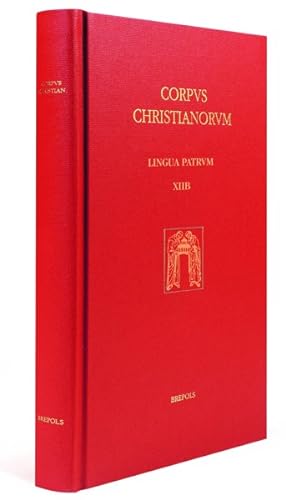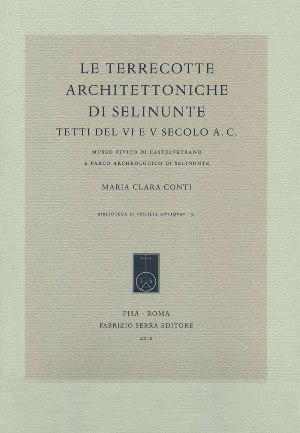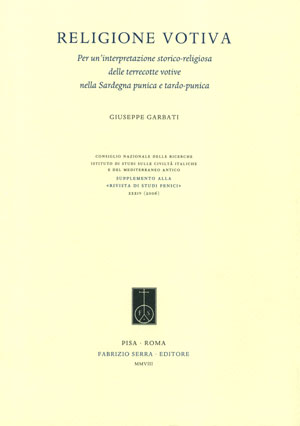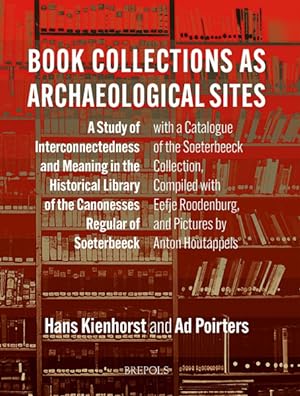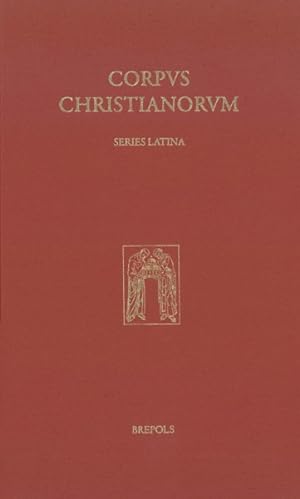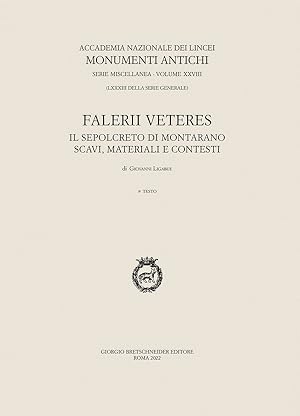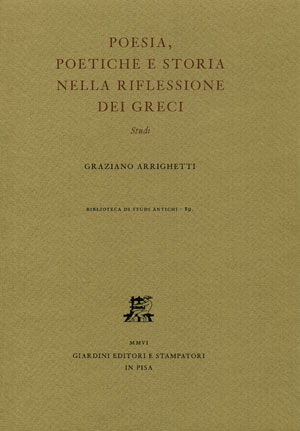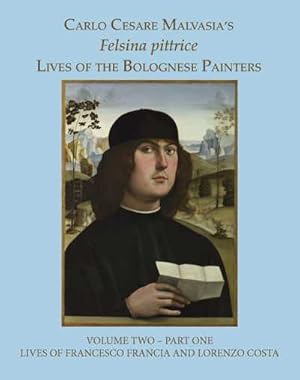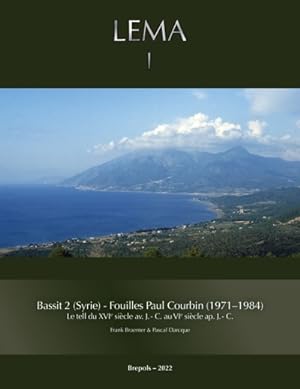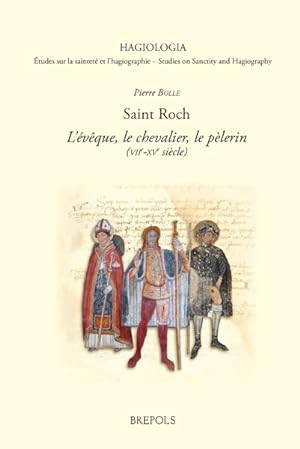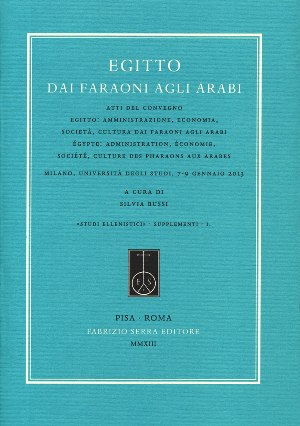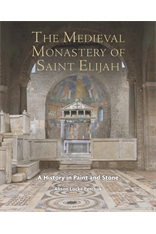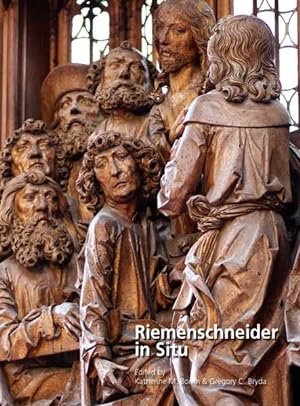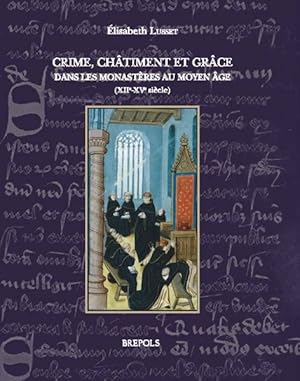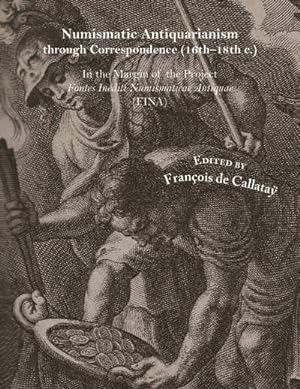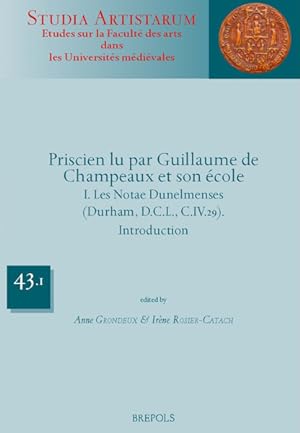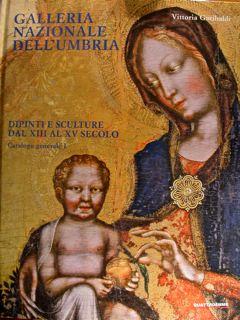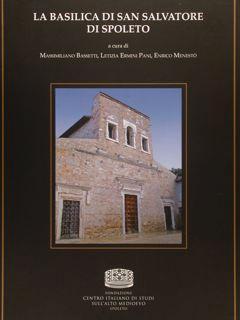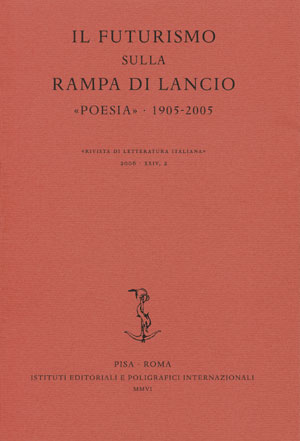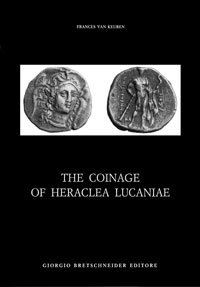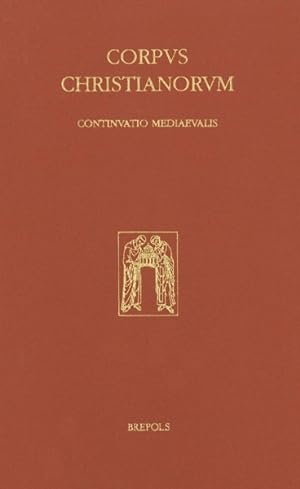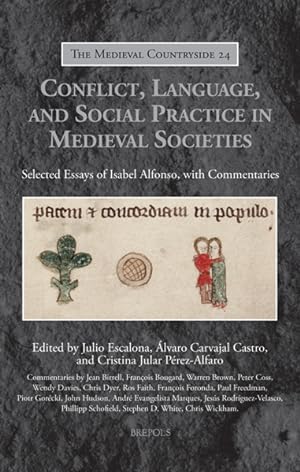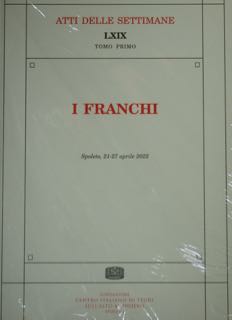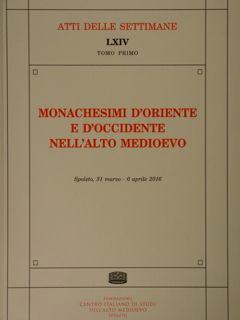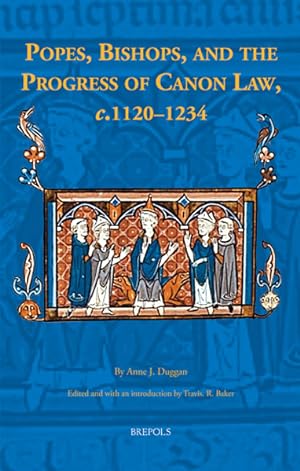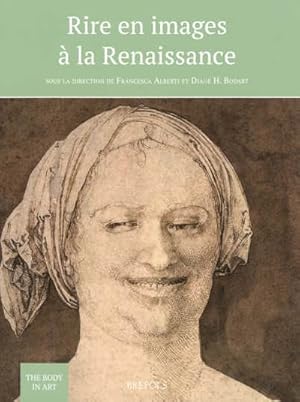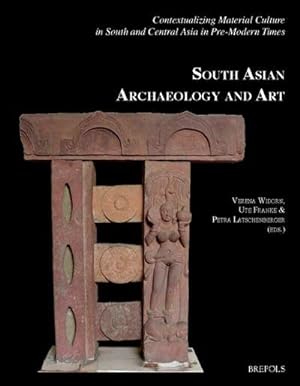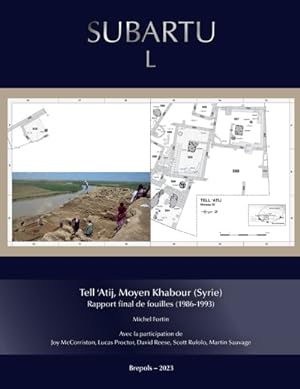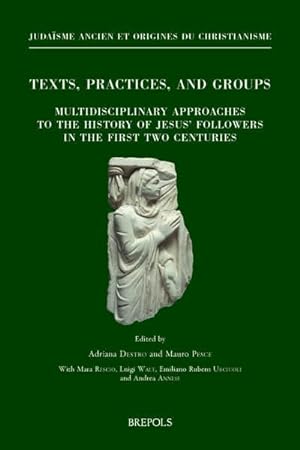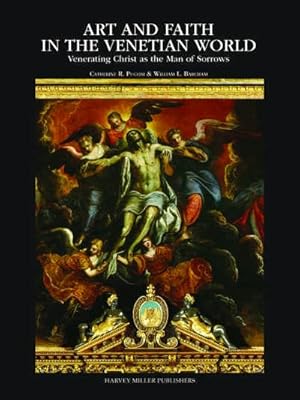Abc or a B C (873 results)
Product Type
- All Product Types
- Books (862)
- Magazines & Periodicals (4)
- Comics
- Sheet Music
- Art, Prints & Posters
- Photographs (1)
- Maps (5)
-
Manuscripts &
Paper Collectibles (1)
Condition
- All Conditions
- New
- Used
Binding
Collectible Attributes
- First Edition (99)
- Signed (1)
- Dust Jacket (92)
- Seller-Supplied Images
- Not Printed On Demand
Seller Location
Seller Rating
-
Latin in Byzantium III: Post-Byzantine Latinitas. Latin in Post-Byzantine Scholarship (15th -19th Centuries)
Seller: Libreria Studio Bosazzi, Firenze, FI, Italy
Book
Rilegato. Condition: nuovo. Ioannis Deligiannis, Vasileios Pappas, Vaios Vaiopoulos (eds). Pages: 490 p. Illustrations:14 b/w, 8 tables b/w., 2 maps b/w. Language(s):English, Latin, Greek. Hardback. Brepols, Publication Year:2021 -- SUMMARY This volume aims at filling a major gap in international literature concerning the knowledge of the Latin language and literature by Post-Byzantine scholars from the fifteenth to the nineteenth centuries. Most of them, immigrants to the West after the Fall of Byzantium, harmoniously integrated into their host countries, practiced and perfected their knowledge of the Latin language and literature, excelled in arts and letters and, in many cases, managed to obtain civil, political and clerical offices. They wrote original poetic and prose works in Latin, for literary, scholarly and/or political purposes. They also translated Greek texts into Latin, and vice versa. The contributors to this volume explore the multifaceted aspects of the knowledge of the Latin language and literature by these scholars. Among the many issues addressed in the volume are: the reasons that urged Post-Byzantine scholars to compose Latin works and disseminate Ancient Greek works to the West and Latin texts to the East, their audience, the fate of their projects, and their relations among them and with Western scholars. In the contents of the volume one can find well known Post-Byzantine scholars such as Bessarion or Isidore of Kiev, as well as lesser known authors like Ioannis Gemistos, Nikolaos Sekoundinos and others. Hence, hereby is provided a canon of scholars who, albeit Greek, are considered essentially as representatives of Neo-Latin literature, along with others who, through their translations, contributed to the rapprochement - literary and political - of East and West. TABLE OF CONTENTS Preface List of Contributors List of Abbreviations Introductory Note A. Introduction Dimitrios Nikitas, An Overview of Post-Byzantine Latinitas B. Greek Studies in the West and Latin Studies in the East in the Post-Byzantine Period and Early Modern Greek Period Christina Abenstein, Treason, Ambition, and Hardship on the Cultural Entanglement of George of Trebizond s Revised Draft of his Translation of Saint Basil Garyfallia Athanasiadou, Reforming a Translation: Nicholas Secundinus s Contribution to the Revised Translation of Arrian s Anabasis of Alexander Made by Bartolomeo Facio Malika Bastin-Hammou, Aemilius Portus, between Greek Scholar and Latin Humanist: Some Relexions on Aemilius Portus s Edition of Aristophanes (1607) Federica Ciccolella, When Cicero Meets Hermogenes: The Defence of Greek Studies in Quattrocento Italy Ioannis Deligiannis, The Diffusion of the Latin Translations of Greek Texts Produced by Late and Post-Byzantine Scholars and Printed from the Mid-Fifteenth to Late Sixteenth Century Michael Malone-Lee, The Latin Translations of Cardinal Bessarion Andreas Ν Michalopoulos & Charilaos Ν Michalopoulos, Modern Greek Translations of Latin Poetic Quotations in the Θέατρον Πολιτικόν (Theatrum Politicum) Vasileios Pappas, The Translation of Justin s Epitome of Trogus by Ioannis Makolas (1686) C. Latin Texts in the Post-Byzantine and Early Modern Greek Period: Theology and Religion, History and Literature, Politics, Ideology and National Identity Ovanes Akopyan, Latin Studies and Greek Scholars in Early Modern Russia Byard Benett, Augustine s Theology as a Resource for Reconciling the Roman Catholic and Greek Orthodox Churches in the Post-Byzantine Period: Maximus Margunius s Greek and Latin Works on the Procession of the Holy Spirit Ilias Giarenis, Leonardo Bruni and Bessarion: Two Scholars, Two Languages, and Two Versions of Liberty in the Fifteenth Century Nikolaos E. Karapidakis, Latinitas or Romanitas Nostra: Latin Culture in the Seven Islands under the Venetian Domination (XIXth-XIXth century) Han Lamers, What s in a Name? Naming the Post-Byzantines in Renaissance Italy (and Beyond) Nikolaos Mavrelos, Latinitas Graecorum: Latin Language Used by Greeks and Greek Identity in Seventeenth-and-Eighteenth-Century Texts Lorenzo Miletti, Between Herodotus and the Poison Maiden. Laonikos Chalkokondyles and the Death of King Ladislaus of Durazzo Sophia Papaioannou, Exempla Virtutis and Augustinian Ethics in De Statu Hominis by Leonardus, Archbishop of Mytilene Theodosios Pylarinos & Vaios Vaiopoulos, Life and Work of a λατινομαθούς Corfiot: Antonio Rodostamo (Ἀντώνιος Ροδόσταμος) Konstantinos Staikos, Eugenios Voulgaris s Edition of Virgil s Aeneid Raf Van Rooy, A Latin Defence of Early Modern Greek Culture: Alexander Helladius s Status Praesens (1714) and its Linguistic Arguments Index of names Index of manuscripts.
-
Brossura. Condition: nuovo. fabrizio Serra, 2012, pp. 350 con 303 figure in bianco/nero n.t -- Il volume presenta uno studio complessivo delle terrecotte architettoniche di Selinunte, la città greca che, fondata sulla costa sudoccidentale della Sicilia, si mostra oggi con l'estensione impressionante delle sue rovine, il razionale disegno dell'abitato, i crolli imponenti dei templi. Il volume considera in modo particolare gli elementi che componevano la copertura, il rivestimento e la decorazione dei tetti realizzati nel corso del VI e del V secolo a.C. per gli edifici della città e dei santuari. L'attuale conoscenza dei tetti fittili selinuntini deriva dai materiali venuti alla luce con le campagne di scavo del XIX e dei primi decenni del XX secolo, custoditi presso il Museo Archeologico Regionale di Palermo e resi noti da una serie di pubblicazioni apparse tra l'ultimo trentennio dell'Ottocento e gli anni sessanta del Novecento. Sono rimasti invece in massima parte sconosciuti la collezione del Museo Civico di Castelvetrano e i reperti provenienti dalle indagini della Soprintendenza sulla cosiddetta acropoli e sulla collina occidentale tra gli anni cinquanta e gli anni ottanta del secolo appena trascorso, conservati presso il Parco Archeologico di Selinunte. La ragion d'essere dello studio presentato in questo volume si fonda quindi soprattutto su tale complesso di materiali inediti, anche se la trattazione non può ovviamente prescindere dagli elementi dei tetti già noti. I frammenti editi vengono pertanto considerati nella presentazione dei diversi complessi individuati e ricompresi nella valutazione generale dei coronamenti fittili degli edifici selinuntini. Le caratteristiche intrinseche, la frammentarietà, la dispersione dei reperti in contesti spaziali e cronologici disomogenei hanno imposto alla ricerca l'adozione di strumenti conoscitivi e interpretativi di carattere essenzialmente filologico e conferito alla presentazione dei risultati un'impostazione analitica e articolata. L'obiettivo di ritrovare e di ricostituire i tetti dei quali i documenti superstiti erano parte è stato perseguito con convinzione, anche se le condizioni di rinvenimento e gli attuali dati di conoscenza della città antica hanno impedito, nella maggior parte dei casi, una loro attribuzione agli edifici di appartenenza. Sommario: Caterina Greco, Prefazione; Premessa. I. Le terrecotte architettoniche di Selinunte: Introduzione; Storia degli studi; I nuovi documenti: Provenienza e consistenza numerica dei reperti; Luoghi e contesti di rinvenimento. Finalità e metodi della ricerca: Obiettivi e limiti; Classificazione e interpretazione: tetti e complessi di terrecotte architettoniche; Problemi di attribuzione e criteri nella definizione cronologica. Presentazione dei risultati: Organizzazione; Testi, tabelle, catalogo; Fotografie e disegni. II. I tetti arcaici: Introduzione; Tetti degli edifici dell'acropoli e di Manuzza: I tetti "sicelioti" (Tetto 1 - "Rivestimento A"; Tetto 2; Tetto 3 - "Terrecotte di grandi proporzioni" - "Dach B"); Tetto 4; Tetto 5; Tetto 6; Tetto 7; Tetto 8 - "Rivestimento B"; Tetto 9; Tetto 10; Tetto 11; Tetto 12; Tetto 13; Tetto 14 .- "Rivestimento C"- "Tetto dei meandri"; Tetto 15); I tetti "corinzi" (Tetto 16; Tetto 17); I tetti "selinuntini" (Tetto 18 - Tetto del tempio C; Tetto 19; Tetti 20 e 22 - Tetto attribuito al tempio Y- "Dach A"; Tetto 20; Tetto 21; Tetto 22; Tetto 23; Tetto 24). Tetti degli edifici della collina occidentale: I tetti "sicelioti" (Tetto 25; Tetto 26 - Tetto del tempio M; Tetto 27). La collezione del museo civico di Castelvetrano: I tetti arcaici (Tetto 8 - "Rivestimento B"); Tetto 18 -Tetto del tempio C; Tetto del tempio E1; Tetto non identificabile). III. I tetti tra il periodo tardoarcaico e la fine del V secolo a.C.: Introduzione; Componenti ed elementi decorativi nei tetti degli edifici dell'Acropoli; I coppi di colmo (Coppi di colmo semicircolari; Coppi di colmo pentagonali a doppia inclinazione; Coppi di colmo pentagonali); Gli acroteri di colmo (Acroteri di colmo A; Acroteri di colmo B; Acroteri di colmo C); Le antefisse di colmo (Antefisse di colmo con volto di Gorgone); Le antefisse laterali (Antefisse con volto di Gorgone; Antefisse con volto di Sileno; Antefisse con volto giovanile; Antefisse con volto non identificabile). IV. I tetti fittili nell'architettura di Selinunte: Premessa; I tetti più antichi e l'affermazione del sistema, "siceliota"; I tetti dei primi grandi edifici templari; Tradizione e innovazione nei tetti "sicelioti" del medio arcaismo; I tetti "corinzi"; La nascita del sistema "selinuntino"; Il tetto del tempio C; Affermazione e sviluppi dei tetti "selinuntini"; I tetti dallo scorcio del VI secolo al 409 a.C.; Le botteghe selinuntine, i materiali e le tecniche della produzione; "Stile" regionale e "caratteri" locali. Bibliografia.
-
Brossura. Condition: nuovo. Supplemento alla «Rivista di Studi Fenici» XXXIV (2006). fabrizio Serra, 2008, pp. 128 con figure in bianco / nero -- Negli ultimi anni l'impulso riservato alle ricerche archeologiche dedicate alla Sardegna di età fenicia, punica e tardo-punica e, con esso, la lettura e la rilettura dei materiali conservati nelle collezioni museali, hanno permesso di raccogliere una rilevante quantità di dati e di usufruire in questo modo di nuove e importanti informazioni su alcune fasi fondamentali della storia antica dell'isola. Oltre a restituire un quadro altamente articolato, i materiali oggi disponibili hanno consentito di approfondire alcuni specifici ambiti della multiforme cultura insulare, offrendo così la possibilità di tratteggiare nelle sue varie componenti - dall'artigianale all'epigrafia, dalle forme produttive alla cultura religiosa - un paesaggio storico profondamente dinamico, esito dell'incontro, della sovrapposizione e dell'interferenza tra civiltà di diversa origine. Nel particolare, tra i vari campi d'indagine al centro dell'attuale dibattito scientifico, ha assunto sempre maggiore importanza e autonomia la sfera della religione, oggetto di questo volume. In questo campo una funzione da non trascurare è assegnabile all'ampia produzione di terrecotte figurate con destinazione votiva, che tanto caratterizza le culture dell'isola durante l'età compresa tra le fasi più mature dell'occupazione cartaginese e l'avvio della conquista romana. Casi significativi, che qui si presentano, sono quelli di Cagliari, Olbia e Nora, anche se l'elenco delle singole attestazioni, come dei contesti urbani ed extraurbani interessati dalla presenza dei votivi fittili, è ben più affollato. Il progredire delle ricerche, quindi, ha offerto gradualmente la possibilità di inserire la Sardegna, in modo forse più consapevole rispetto al passato, all'interno di un'ampia koinè culturale che, tra il V e il II/I secolo a.C., abbraccia pressoché tutto il bacino del Mediterraneo, trovando, proprio nelle produzioni fittili, nelle loro iconografie e nella loro funzionalità, un significativo elemento di caratterizzazione. È pertanto alla crescente centralità degli ex voto fittili nel panorama artigianale e religioso di Sardegna che va attribuita in primo luogo la nascita del presente lavoro, dedicato ad un tentativo di lettura storica e storico-religiosa dei votivi stessi. All'opportunità di poter accedere ad un simile complesso di dati, anche recentissimi, si deve aggiungere l'interesse per un ambito della religione ritenuto generalmente «modesto» e apparentemente lontano dalle più «alte» forme della ritualità cittadina: nonostante l'«umiltà» artigianale dei votivi e la loro usuale ricorrenza in ambiti sociali non elevati, le terrecotte destinate ai santuari rimangono a tutt'oggi uno degli elementi più distintivi e informativi su molteplici caratteri della religiosità insulare (e più ampiamente mediterranea). Sommario: Premessa. Capitolo primo. Metodologia e obiettivi: 1. Religione votiva: definizione e inquadramento; 2. I contesti e i materiali: aspetti e problemi dell'indagine; 3. Note terminologiche (3. 1. «Favisse» e «stipi»). Capitolo secondo. La documentazione archeologica. Distribuzione e fisionomia: 1. Il territorio di Cagliari e la regione centro-meridionale della Sardegna; 2. Il territorio del Golfo di Oristano; 3. La fascia nord-occidentale e il Sassarese; 4. La regione centrale interna; 5. Olbia e il suo territorio. Capitolo terzo. La documentazione archeologica. Le terrecotte votive: 1. I «fedeli sofferenti» e la tradizione fenicia; 2. L'eredità fenicia: le immagini di Bes; 3. L'impulso greco: le statuette di divinità femminili (3. 1. I thymiateria a testa femminile); 4. La tradizione italica e gli ex voto anatomici; 5. La tradizione italica: i devoti e la statuaria fittile; 6. Varia; 7. I contesti e il materiale votivo. Osservazioni generali (7. 1. Il caso di Santa Gilla); 8. Religione votiva: prime considerazioni. Capitolo quarto. Religione popolare, religione personale. Riflessioni sulla terminologia e sul metodo: 1. Premessa; 2. Artigianato popolare e religione popolare; 3. Autonomia e individualità del voto: il caso di Linna Pertunta; 4. Religione popolare: fluidità simbolica e problemi applicativi; 5. Le divinità: problemi di riconoscimento. Capitolo quinto. Le divinità femminili e i culti agrari e fertilistici: 1. La dea e le messi (1. 1. Il racconto diodoreo sul culto di Demetra e la documentazione cartaginese; 1. 2. Le terrecotte con divinità femminili in Sardegna: iconografia e iconologia; 1. 3. Demetra / Cerere tra Cartagine e Roma). Capitolo sesto. Tra oriente e occidente: la sanatio e il «culto delle acque»: 1. La sanatio: i votivi e le acque; 2. Il «devoto sofferente» a Bitia e a Neapolis: la sanatio come fenomeno sociale (2. 1. I «devoti sofferenti» e il culto di Eshmun/Esculapio in Sardegna); 3. L'iconografia di Bes: un'immagine «in prestito» (3. 1. Il problema della continuità); 4. Il «culto delle acque»: problemi ed elementi di distinzione (4. 1. Le acque e il culto tra la tradizione nuragica e l'età ellenistica: proposte di lettura); 5. L'acqua tra sanatio e fertilità. Capitolo settimo. Religione votiva e sistema religioso «ufficiale»: 1. [S]D 'DR B'BY. Antenato progenitore; 2. [S]D 'DR B'BY. Antenato guaritore; 3. Demetra ad Antas? 4. Le terrecotte votive e il culto «pubblico»: interferenze e autonomie. Elenco delle figure. Abbreviazioni bibliografiche.
-
Rilegato. Condition: nuovo. Pages: 716 p. Illustrations:15 b/w, 267 col., 3 tables b/w. Language(s):English. Hardback. Brepols, Publication Year:2023 -- SUMMARY In 1997 the canonesses regular of Soeterbeeck moved from their convent in Deursen (the Netherlands) to a nursing home in Nuland. They left behind an old library of considerable size and historical significance that is now the core of the Soeterbeeck Collection at Nijmegen University Library. It is a suitable starting point for telling the story of the historical library of a women s convent with roots in the Modern Devotion, from the community s humble beginnings in 1448 to the present day. This study describes the collective history of all manuscripts and early printed books that are known to have been in communal or personal ownership at Soeterbeeck. It investigates the books production and delves into their traces of use. Many of these are connected to each other, usually because they were left by the same person or had the same purpose. Such units transcend the level of individual volumes and reveal what might be called the stratification of the historical library as a whole. They can be interpreted in the context of the sisters personal lives and the convent s communal history. This approach provides insight in the multiplicity of meanings that the books had for their users. For the first time, theoretical principles of modern archaeology are used to map a historical library as an archaeological site. A scholarly catalogue of the Soeterbeeck Collection that documents its traces of use is also included. Stunning illustrations visually lay bare the books eventful lives. TABLE OF CONTENTS Part I Study Chapter 1 An Archaeological Approach 1.1 The Madonna of Soeterbeeck 1.2 The Historical Library 1.3 A Book Collection as an Archaeological Site 1.4 Plan of the Following Chapters Chapter 2 Faithful to the Divine Office 2.1 The First Phase 2.2 Choir Books Attributed to Mariënhage 2.3 Two Stratigraphic Units in Choir Books Chapter 3 In Times of Trouble 3.1 The Fire of 1539 3.2 Book Production at Soeterbeeck 3.3 Ownership Notes from the Years 1606-1608 3.4 Books that Came in 1613 3.5 Aftermath Chapter 4 Personal Ownership of Books in a Monastic Environment 4.1 Two Circuits 4.2 The Sisters of 1632 and Their Books 4.3 Not to Forget 4.4 After the Relocation 4.5 Sister Lips s Booklets 4.6 Books in the Choir Stalls Chapter 5 Changing Attitudes towards Old Books 5.1 Cut to Pieces or Sold 5.2 First Signs of a Library 5.3 Revaluation Chapter 6 On the Edge of Beyond 6.1 Special Attention for the Manuscripts 6.2 Witnessing to a Tradition 6.3 The Soeterbeeck Collection 6.4 Towards an Archaeology Chapter 7 Back to Hodder Appendices A Books with Ownership Notes of the Convents of Soeterbeeck and Nazareth B Alienated Books C Books in the Archives of Soeterbeeck D Shelf-Marks on Labels of Woody Paper (ca 1952) E Fragments from the Winter Part of an Antiphonary Excursuses 1 The Term Stratigraphic Unit 2 A Bindery at Mariënhage 3 Incongruities in the Additional Office for Anthony Abbot in IV 4 and IV 22 4 Mysteries surrounding Psalter IV 75 5 Antonius van Hemert 6 Catharina Dekens 7 A Spiritual Exercise at Mass 8 A View on the Seventeenth-Century Convent 9 A Nuns Gallery at Soeterbeeck 10 The Uncertain Origin of Mater 2 11 The Contents of IV 12 The Choir Stalls of Soeterbeeck 13 The Duration of Petronella van Berckel s Priorate 14 Issues about Wouter Willems s Rectorate 15 Rumbling in the Convent 16 From Sister Verhoeven with Compliments 17 The Bishop s Rule 18 A Sister s Hand on Loose Leaves in IV 15 19 Against the Plague 20 Names of Loved Ones in Two Printed Books 21 Copies of the Windesheim Officia propria from St Joseph-Nazareth in Antwerp 22 A Bookcase in the Choir 23 Two Books near the Prioress 24 Books of Lay Boarders 25 Soeterbeeck s Antiphonaries 26 The Feast of Vincent of Saragossa in Soeterbeeck s Graduals 27 The Patched-Up State of IV 78 28 The Present State of IV 24 29 Lots 64-66 and 70-72 in the Auction Catalogue of the Estate of Theresia Smits 30 Made by Antoon Hermans 31 More Roads to Haaren 32 Exceptionally Black 33 The Notebooks of ENK AR-Z104/545 34 Tight Links between the Text Block and Endpapers of The Hague, 130 G 18 35 The Sections of the Library of 1958 36 Soeterbeeck s Books on Display 37 From Another Past 38 Books in the Care of Van Dijk Part II: Catalogue of the Soeterbeeck Collection Introduction In General Titles Annotations Traces of Use The Sisters Old Library Case III Case IV Case V.
-
Rilegato. Condition: nuovo. Roger Gryson (ed). Pages: 314 p. Illustrations:1 tables b/w. Language(s):Latin, French. Publication Year:2017. Brepols. ISBN: 978-2-503-57122-5. Hardback -- SUMMARY De l uvre de Victorin de Poetovio, qui, d après ce qu en dit Jérôme, était considérable, peu de chose nous est parvenu. Mis à part un court traité sur la semaine primordiale (CPL 79) et une note sur la chronologie de la vie du Christ prise dans les archives d Alexandre de Jérusalem, l essentiel de son héritage littéraire est constitué par un commentaire de l Apocalypse composé vraisemblablement sous Gallien, dans les années 260 (CPL 80). Jusqu il y a un siècle, ce commentaire était connu seulement à travers une édition revue et corrigée par Jérôme. Encore lisait-on le plus souvent cette édition sous une forme profondément remaniée durant le haut moyen âge, car c est celle-là qui est reproduite par Migne. En 1916, Johannes Haussleiter a publié dans le Corpus de Vienne une édition critique où le texte original, redécouvert par lui dans un manuscrit du Vatican, et le texte hiéronymien étaient présentés en parallèle. Cette édition mérite aujourd hui d être refaite. Des manuscrits importants étaient inconnus de Haussleiter. Il a également commis diverses erreurs de jugement, qui s expliquent par la connaissance imparfaite qu on avait alors des anciens commentaires latins de l Apocalypse. Plus récemment, Martine Dulaey a sorti la figure attachante de l évêque martyr de Poetovio de l ombre dans laquelle l avait relégué la perte de la plupart de ses écrits, en publiant une étude exhaustive sur sa vie, son uvre, sa doctrine. La présente édition critique, qui prend en considération l ensemble de la tradition, se veut le complément et, d une certaine façon, la justification de l édition du texte original de Victorin qu elle a donnée dans la collection des Sources chrétiennes. Elle rendra justice à un auteur trop peu connu, dont l influence fut considérable à la fin de l antiquité et jusqu à l'époque carolingienne. TABLE OF CONTENTS Victorinus Poetoviensis Tractatus de fabrica mundi ( CPL 79 ) ed. R. Gryson Victorinus Poetoviensis Commentarii in Apocalypsim Ioannis ( CPL 80 ) ed. R. Gryson.
-
Falerii Veteres. Il sepolcreto di Montarano. Scavi, materiali e contesti
Seller: Libreria Studio Bosazzi, Firenze, FI, Italy
Book
Brossura. Condition: nuovo. GIORGIO BRETSCHNEIDER, 2022, L-750pp di testo - 350 tavole di cui 190 fotografiche. NUOVO - Oggetto del volume è uno dei più antichi sepolcreti di Falerii (odierna Civita Castellana, VT), in loc. Montarano, databile tra la fine dell età del Ferro e la fine dell età orientalizzante (750-600 a.C. circa) che, pur scavato alla fine dell'Ottocento, non era ancora stato analizzato nel dettaglio. Oltre 1700 reperti costituiscono il catalogo delle 67 tombe esaminate. Lo studio si articola su due livelli in stretta connessione: archivistico, archeologico-topografico. Frutto di una revisione sistematica della documentazione d'archivio, i risultati portano a meglio definire le caratteristiche delle fasi più antiche di Falerii e ad evidenziare i rapporti cronologici e culturali con i territori vicini (Etrusco, Capenate, Lazio e Centro-Italico). This work is articulated on two levels: archival and archaeological, which are closely connected. The object of the research is the most ancient burial ground of Falerii Veteres (since a continuity of settlement is recognized in the area: VIII-VII century B.C.) which, although excavated at the end of the nineteenth century, has not yet been thoroughly analyzed. More than 1700 finds have been preserved, which form the catalog of 67 funerary contexts. Those objects are mostly preserved at the Museo dell Agro Falisco of Civita Castellana, but also at the Museum of Villa Giulia and at the Pigorini Museum in Rome, at the National Museum of Florence and at the Civic Museum of Bologna.
-
Poesia, poetiche e storia nella riflessione dei Greci. Studi
Seller: Libreria Studio Bosazzi, Firenze, FI, Italy
Book
Brossura. Condition: nuovo. Giardini editore, 2006, pp. XVI-524 - BIBLIOTECA DI STUDI ANTICHI Diretta da Graziano Arrighetti, Mauro Tulli -- Le ricerche contenute in questo volume, spaziando in tutto l'arco della letteratura greca antica, prendono in considerazione, negli autori esaminati, la varietà e la complessità della loro posizione nei confronti della tradizione, sia quella delle forme letterarie che quella dei complessi di idee e di valori che in quelle forme erano proposti. L'indagine muove dall'epica, omerica e postomerica, ed all'epica, fino ad Epimenide, sono dedicate le ricerche della prima parte, che comprende anche studi sulla lirica e sul teatro. La seconda parte, dedicata alla posizione della filosofia nei confronti della letteratura e della storia, parte dalle posizioni di Platone ed Aristotele per arrivare ad analizzare le riflessioni dei Peripatetici e degli Epicurei nei confronti della cultura e della tradizione letteraria. Sommario: Parte I: La poesia. Saperi, forme del pensiero, strumenti espressivi. Capitolo I: L'epica: 1. Esiodo e le Muse: i limiti di un dono: a. La rivelazione della verità; b. Il canto e gli strumenti espressivi; c. Quello che il poeta non sa. Appendice: L'Odisseo omerico, la [patha] e il [logos]. 2. Esiodo e le convenzioni dell'epos. Ovvero, doppie redazioni e legge di Zielinski. 3. Tecnica catalogica esiodea: Notte e i suoi figli (Esiodo, Teog. 211-225). 4. Etica eroica e continuità genealogica nell'epica. Appendice: L'importanza di essere figlio di Odisseo e di Penelope. 5. Da [to kairion] di Omero a [o kairos] di Esiodo e oltre. Appendice: Il riso di Omero, il riso di Esiodo. 6. Fra purificazioni e produzione letteraria: la Teogonia di Epimenide. Capitolo II: Oltre l'epica: 1. Stesicoro fra tradizione e innovazione: a. Il rapporto con l'epica; b. Le peculiarità dei caratteri; c. La scelta dei temi; d. L'estensione della materia. 2. Stesicoro, Quintiliano e la Poetica di Aristotele. 3. Pindaro, Pitica IV: una richiesta non tradizionale ad Arcesilao di Cirene. 4. Euripide e la [orthotes ton epon]. 5. Euripide, la tragedia e Socrate (Aristofane, Rane 1491-1499). Parte II: I filosofi, la letteratura, la storia: le forme, i contenuti. Capitolo I: Platone e Aristotele. Poesia, mito e storia: 1. Platone, Timeo-Crizia e la rappresentazione della storia. 2. La poesia: Solone e il poema su Atlantide. 3. Platone, il mito e la tradizione letteraria. 4. Aristotele fra storia e poesia. La coerenza della mimesis. 5. Solone legislatore: il Fedro e l'Athenaion Politeia. 6. Aristotele storico nell'Athenaion Politeia: a. Le accuse a Solone; b. Il viaggio di Solone in Egitto; c. [Semeion, tekmerion, to eulogon]; d. Dopo Salamina: la "costituzione dell'Areopago". Appendice: Un secolo di edizioni dell'Athenaion Politeia (1891-1991). Capitolo II: I Peripatetici: 1. Fra letteratura e biografia: a. Critica letteraria e biografia; b. La funzione dell'aneddoto; c. L'Athenaion Politeia: produzione letteraria e ricostruzione storica; d. I Peripatetici, predecessori e continuatori. Appendice: La biografia greca e gli studi laerziani di Marcello Gigante. Capitolo III: Gli Epicurei: la riflessione sulla letteratura, la biografia: 1. Gli Epicurei, la poesia e Lucrezio: a. Da Epicuro a Filodemo; b. Lucrezio e la tradizione letteraria. 2. Filodemo, Lucrezio e le poetiche dell'Ellenismo: a. I problemi; b. Aristotele, Filodemo e le poetiche dell'Ellenismo; c. La poetica di Filodemo e le poetiche dell'Ellenismo; d. Lucrezio e Filodemo. 3. Poesia, mito e storia in Filodemo: a. I precedenti; b. La riflessione sulla poesia; c. Il [peri eusebeias]; d. La storiografia filosofica. 4. Filodemo biografo dei filosofi e le forme dell'erudizione: a. Il problema; b. La Rassegna dei filosofi; c. Il rapporto con l'erudizione; d. La produzione biografica e le opere sul Kepos. Appendice: Gli studi epicurei di Hermann Usener: a. Gli Epicurea e il Glossarium Epicureum; b. Lucrezio nella produzione epicurea di Usener. Bibliografia. Indici: Indice dei luoghi discussi. Indice dei principali nomi e argomenti.
-
Carlo Cesare Malvasia. Felsina pittrice: The Lives of Francesco Francia and Lorenzo Costa
Seller: Libreria Studio Bosazzi, Firenze, FI, Italy
Book
Rilegato. Condition: nuovo. Edited by Elizabeth Cropper, Lorenzo Pericolo. Pages: xxxiv + 410 p. NEW. Hardback. Illustrations:14 b/w, 163 col. Language(s):English, Italian. Brepols, Publication Year:2022 - SUMMARY In Bologna, Giorgio Vasari s maniera moderna is inaugurated through the art of the goldsmith-painter Francesco Francia (c.1447 1517). Malvasia assimilates the beginning of this new era with the end of night and the crack of dawn, when never before seen colors are revealed to the eyes with extraordinary intensity. In his life of Francia, Vasari had acknowledged the role of precursor played by this Bolognese master in the history of Italian painting. By the same token, he had tarnished Francia s reputation by alleging that he had died soon after unpacking Raphael s Ecstasy of Saint Cecilia upon its arrival in Bologna. His death, Vasari insisted, was a moment of reckoning: it was then that Francia recognized his artistic inferiority and damnation with regard not only to Raphael, but also to the highest achievements of the maniera moderna. Aware of the historical validity of Vasari s account, Malvasia lifted it wholesale into his Felsina pittrice, but not without bringing its author to trial by examining his biased testimony in light of the rich documentary evidence he had gathered against his narrative. Equipped with the most refined tools of forensic eloquence, seething with outrage, Malvasia is at his best in challenging Vasari s historical distortions and prejudices not only in connection with Francia, but also his disciples, Timoteo Viti (1469 1523), Lorenzo Costa (1460 1535), and Giovanni Maria Chiodarolo (1480 1530). Denouncing Vasari s silence about the works and importance of Francia s progeny in particular Giacomo (1484 1557) and Giovan Battista Francia Malvasia explains how the activity of these masters promoted the education and social status of painters in Bologna before the foundation of the Carracci Academy in 1582. Illustrated with numerous color images (many of them taken expressly for this publication), this volume provides a critical edition and annotated translation of Malvasia s lives of Francia and his disciples, among them prominently Costa. The integral transcription (for the first time) in this volume of Malvasia s preparatory notes (Scritti originali) to the lives of Francia, Costa, and Chiodarolo presents important material that could foster the study of Bolognese painting in the age of humanism under the rulership of the Bentivoglio.
-
Bassit 2 (Syrie) - Fouilles Paul Courbin (1971-1984). Le tell du XVIe siècle av. J.- C. au VIe siècle ap. J.- C.
Seller: Libreria Studio Bosazzi, Firenze, FI, Italy
Book
Brossura. Condition: nuovo. Pages: xii + 394 p. Illustrations:1809 b/w, 59 col., 126 tables b/w., 3 maps b/w. Language(s):French. Brepols, Publication Year:2023 -- SUMMARY À 50 km au Nord de Lattaquié, le site côtier de Bassit a été étudié sous la direction de Paul Courbin : après l acropole (1971 1972) (périodes hellénistique et romaine), et la nécropole du Fer (1973 1974), le « tell » a été fouillé de 1972 à 1984. Sont présentés ici une description détaillée de la stratigraphie et de l architecture du « tell », des ensembles céramiques associés, ainsi que le corpus du mobilier datant du Bronze Récent I et II. Bassit est installé aux marges Nord du royaume d Ougarit à partir du milieu du XVIe s. av. J.-C. Les importations chypriotes sont nombreuses durant tout le Bronze Récent, mais la céramique égéenne apparaît très rare. Le site est détruit bien avant le passage des « peuples de la mer » (vers 1200). A l âge du Fer, la fonction constante de Bassit est de contrôler l accès maritime depuis Chypre et le cabotage littoral. Le commerce de la céramique chypriote domine le Fer I et II, celui des céramiques égéennes et étrusques, puis attiques, le Fer III. À l époque hellénistique, la production d amphores et de monnaies confirme l identification de Posideion avec Bassit. L époque romaine est également marquée par une importante production de céramique. TABLE OF CONTENTS Avant-propos Introduction FRANK BRAEMER, PASCAL DARQUE & JACQUES Y. PERREAULT 1. Le paysage et la morphologie du site; l'exploration archéologique du tell FRANK BRAEMER, PASCAL DARQUE 2. Stratigraphie, architecture et groupes de mobilier du Bronze Récent I et II PASCAL DARQUE 3. Le mobilier du Bronze Récent I et II PASCAL DARQUE 4. La réoccupation du site après la destruction des édifices du Bronze Récent FRANK BRAEMER 5. Stratigraphie, architecture et groupes de mobilier du Fer IIA récent et du Fer IIB FRANK BRAEMER 6. Stratigraphie, architecture et groupes de mobilier du Fer IIIA FRANK BRAEMER 7. Stratigraphie, architecture et groupes de mobilier du Fer IIIB FRANK BRAEMER 8. Stratigraphie, architecture et mobilier de l époque hellénistique FRANK BRAEMER 9. Stratigraphie, architecture et groupes de mobilier des époques romaine tardive et byzantine FRANK BRAEMER 10. L occupation du tell dans l histoire de Bassit FRANK BRAEMER ET PASCAL DARQUE Bibliographie.
-
Saint Roch. L'évêque, le chevalier, le pèlerin (VIIe-XVe siècle)
Seller: Libreria Studio Bosazzi, Firenze, FI, Italy
Book
Rilegato. Condition: nuovo. Pages: 953 p. Illustrations:62 b/w, 122 col., 77 tables b/w., 7 maps b/w. Language(s):French. Brepols, Publication Year:2023. Hardback - SUMMARY En ne retenant des deux Vies de saint Roch publiées par les bollandistes que ce qui s accordait avec l Histoire, en dépit de leurs incohérences, l érudition s était employée jusqu ici à construire la « biographie vraisemblable » d un pèlerin thaumaturge de la deuxième moitié du XIVe siècle. Outre de nouvelles vitae, l auteur investigue de manière exhaustive toutes les autres dimensions négligées d un dossier hagiographique complexe : celles de la liturgie, des archives civiles, des reliques et de l iconographie. Il en publie et analyse un corpus exceptionnel de documents inédits, dont certains précèdent les récits de plusieurs décennies. Il en ressort une figure inattendue et bien différente de celle qui résultait du traitement traditionaliste et trop exclusif des documents littéraires. Elle s enracine dans celle d un évêque mérovingien d Autun, se « rénove » sous l effet de la peste dans la liturgie languedocienne de la fin du XIVe siècle, puis se dédouble dans l iconographie italienne de la première moitié du XVe siècle. Elle s inscrit enfin dans un roman du dernier tiers du siècle, plusieurs fois remanié, que le nouveau vecteur de l imprimerie propulsera à travers toute l Europe, en deux décennies à peine. Cette vaste enquête heuristique, conçue dans le strict héritage de l hagiographie critique, apporte encore une contribution méthodologique et épistémologique originale à la stemmatique des réécritures, à l étude des faux « vols pieux » de reliques et à l exploitation de l iconographie. Elle entend aussi alimenter la réflexion sur la notion de dévotion populaire et sur les phénomènes et les groupes sociaux qui la génèrent. Publié avec le concours de la Fondation Universitaire de Belgique, de la Fondation André Vauchez (Académie des Inscriptions et Belles-Lettres), et du Centre d études médiévales de Montpellier (Université Paul Valéry Montpellier 3) TABLE OF CONTENTS Préface de Guy Philippart Introduction : un saint paradoxal I. L historiographie : la fabrication d une biographie vraisemblable A. Les Acta Sanctorum et le commentaire de Jan Pien (Pinius) B. Cornelius Flaminius : la scuola et le rapt des reliques C. Montpellier : un prosélytisme tardif D. La « nouvelle chronologie » ou la foi dans les Acta Breviora E. L assimilation de la « nouvelle chronologie » F. Les travaux récents, l intérêt pour l expansion du culte et son contexte G. Quelques monographies régionales ou locales H. Les cahiers de la Scuola Grande I. La « nouvelle chronologie » et son pilier : le statut des Acta Breviora J. Les impasses de la méthode traditionaliste : l introuvable biographie K. Conclusion II. Le dossier littéraire : fusion, réécritures et rationalisations A. La Vita sancti Rochi B. La descendance de la Vita sancti Rochi : la Vie en moyen français de Jehan Phelipot C. Les autres descendants de la Vita sancti Rochi D. L Anonyme allemand E. Les Acta Breviora F. Adaptations et traduction des Acta Breviora : bas allemand, néerlandais et islandais G. Quelques inclassables H. L exploitation du matériau littéraire connu avant 2004 I. Le Poème italien redécouvert en 2004 : saint Roch repart vers l Angleterre J. La seconde découverte de 2004. Dal Bovo : un saint Roch Anglais K. Le travail sur le sens : le « degré d invraisemblance » L. Le travail sur la forme : une nouvelle analyse synoptique M. Conclusion III. Le dossier documentaire : Tempeste et peste A. Liturgie et archives françaises B. Liturgie et archives italiennes C. Au nord des Alpes D. Conclusion : un saint rénové en Languedoc et dédoublé en Italie IV. Les reliques : rumeurs, faux et ratures A. Enjeux, formes littéraires et versions B. La tradition vénitienne. Chroniques et martyrologes. C. La version du « vol pieux » D. La version arlésienne E. Conclusion V. L iconographie : la préhistoire du saint pèlerin A. La France : un évêque disparu et un pèlerin tardif B. L Italie : le chevalier et le pèlerin C. Au nord des Alpes : l importance de l imprimerie D. Conclusion VI. Conclusion générale A. Vertus et limites de la grande synthèse B. Heuristique et méthode C. Processus à l uvre et mentalités D. Poursuivre la recherche VII. Annexes documentaires A. Vitae, éditions, stemmatique et méthode de Froger B. Sources liturgiques ayant trait à Roch évêque C. Délibérations du Conseil des Dix et Scuola Grande di San Rocco (1478-1499) D. Scuola Grande Arciconfraternita di San Rocco. Actes relatifs aux reliques E. Liber provisionum de Voghera, 1483. Vente des reliques par le frère Theotonicus F. Remise des reliques des trinitaires d Arles aux trinitaires de Grenade, 2 juin 1501 Épilogue.
-
Egitto. Dai Faraoni agli Arabi. Atti del Convegno 'Egitto: amministrazione, economia, società, cultura dai Faraoni agli Arabi. Égypte: administration, économie, société, culture des Pharaons aux Arabes', Milano, Università degli studi, 7-9 gennaio 2013
Seller: Libreria Studio Bosazzi, Firenze, FI, Italy
Book
Brossura. Condition: nuovo. a cura di Silvia Bussi. Fabrizio Serra, 2013, pp. 280 con figure in bianco/nero e a colori n.t. -- Il volume raccoglie gli Atti del convegno 'Egitto: amministrazione, economia, società, cultura dai Faraoni agli Arabi', tenutosi a Milano nel gennaio 2013, convegno che ha voluto essere momento di esposizione, confronto e dibattito tra studiosi di provenienze molto diversificate in merito, appunto, all'Egitto, cantiere e laboratorio privilegiato per lo studio delle interazioni di lunga durata tra civiltà incontratesi e succedutesi sul medesimo territorio. Un panorama di oltre quattro millenni da cui emerge una visione chiara e articolata della storia, della cultura e dell'organizzazione economico-sociale del Paese, dalla fase di formazione dello Stato, tra la fine del IV e l'inizio del III millennio a.C., fino agli splendori espansionistici 'imperiali', dalle invasioni di diverse potenze straniere alla rinascita finale del Paese, che lascerà poi forzatamente il posto ai dominatori greci, romani, arabi. I contributi rispecchiano il calendario dei lavori che si sono svolti in tre giorni, il primo dedicato all'Egitto faraonico e copto, il secondo all'Egitto ellenistico ed il terzo all'Egitto romano e tardoantico. La linea interpretativa comune alle tre giornate è stata di cercare di individuare, attraverso l'analisi specialistica calata nelle singole fasi cronologiche della Storia dell'Egitto antico, gli aspetti amministrativi, sociali, economici e culturali, al fine di rilevarne elementi di continuità, di trasformazione, di mutamento, a tratti profondo, nella complessa struttura della società, mano a mano che si succedettero situazioni politiche che portarono un Egitto indipendente a divenire soggetto prima ai Persiani, poi ai Macedoni e infine ai Romani. Sommario: Silvia Bussi, Premessa; Patrizia Piacentini, Introduzione alla giornata dedicata all'Egitto faraonico e copto; Silvia Bussi, Introduzione alle giornate ellenistica, romana e tardoantica; Edda Bresciani, Presentazione; Pascal Vernus, L'acte fondamental du pouvoir dans l'Égypte pharaonique: l''ordre royal' (oudj-nesou); Patrizia Piacentini, Beginning, Continuity and Transformations of the Egyptian Administration in the IIIth Millennium BC?: the Scribal Titles; Stephen Quirke, Fragment Epistemology? Profiling the Society and Economy of Late Middle Kingdom Lahun; Christian Orsenigo, «Venite a me, voi che desiderate vedere Amon!»: Amenhotep figlio di Hapu negli Archivi di Egittologia dell'Università degli Studi di Milano; Willy Clarysse, The Use of Demotic in the Ptolemaic Administration; Anne-Emanuelle Veïsse, L'expression de l'identité dans les pétitions d'époque ptolémaïque. Étude préliminaire; Katelijn Vandorpe, A Happiness Index for Antiquity? Hellenistic Egypt as a Case-Study; Gilles Gorre, Sylvie Honigman, Kings, Taxes and High Priests: Comparing the Ptolemaic and Seleukid Policies; Silvia Bussi, Fiscalità e templi nell'Egitto tolemaico; Chatarine Lorber, The Grand Mutation: Ptolemaic Bronze Currency in the Second Century B.C.; Bernard Legras, Autour du papyrus dit de Cléopâtre: les prostagmata lagides et les interactions romano-égyptiennes; Luigi Gallo, Aspetti demografici dell'Egitto greco-romano; Barbara Anagnostou-Canas, Les prêtres de Bacchias face à l'administration romaine; Kai Ruffing, The Trade with India and the Problem of Agency in the Economy of the Roman Empire; Maria Federica Petraccia, Il ruolo dell'esercito in occasione dello scisma donatista e il trattato contro i Donatisti di Optatus Milevitanus; Tito Orlandi, La copticità dell'Egitto copto; Marco Di Branco, Alla conquista del passato: la storia dell'antico Egitto vista dagli Arabi; Daniele Foraboschi, Conclusioni. Recapiti dei collaboratori del volume.
-
The Medieval Monastery of Saint Elijah: A History in Paint and Stone
Seller: Libreria Studio Bosazzi, Firenze, FI, Italy
Book
Rilegato. Condition: nuovo. 432 p., 10 b/w ill. + 150 colour ill., 2 b/w tables, 216 x 280 mm, 2021. Languages: English. Hardback - A methodologically ambitious, sumptuously illustrated, and erudite study of a twelfth-century monastery near Rome that offers a compelling biography of a neglected Romanesque jewel as well as evocative multisensory readings of its architecture, frescoes, and sculpture. Blending innovative art historical analysis with archaeology, epigraphy, history, liturgy, theology, and landscape and memory studies, The Medieval Monastery of Saint Elijah: A History in Paint and Stone is the first comprehensive interdisciplinary study of a deeply intelligent yet understudied male Benedictine convent near Rome. The only monastery known to have been dedicated to the prophet Elijah in the Latin West, it was rebuilt c.1122 26 with papal patronage. Today, the monastery is represented by its church of Sant Elia, a stone basilica endowed with its original Cosmati marble pavement and liturgical furnishings, early and high medieval sculptures and inscriptions, and vibrant wall paintings that include unique depictions of the prophet Elijah and the twelve tribes of Israel as warriors, an apse program with a distinctly elite Roman origin, and an important narrative cycle of the Apocalypse. An outlying chapel marks the site of a theophany that sanctified the landscape and gave the monastery its raison d être. The Medieval Monastery of Saint Elijah makes significant contributions to current art historical debates concerning communal identity and the construction of social memory, artistic creativity and processes, the multisensory and exegetical capacities of works of visual art, intersections of topography and sanctity, and the effects of medievalism on our understanding of the Middle Ages.
-
Rilegato. Condition: nuovo. Katherine M. Boivin, Gregory C. Bryda (eds) - Pages: 416 p.Illustrations:33 b/w, 222 col., 1 maps b/w. Language(s):English. Brepols, Publication Year:2022. Hardback - SUMMARY Riemenschneider in Situ presents the newest research on the work of one of the most famous late medieval and early Renaissance sculptors, Tilman Riemenschneider. Moving beyond questions of style, date, and workshop practice, this volume investigates the sculptor s programs across the south German region of Franconia that survive in situ, within the particular contexts for which they were designed and in which they were originally experienced. In shifting the focus from fragmentary pieces in museum collections to extant installations in their original church settings, the volume contributes to a wave of scholarship interested in reanimating medieval artistic ensembles by considering them as complex visual environments. Together, the authors conservators, museum professionals, and art historians provide an essential and overdue study of Riemenschneider s best-preserved pieces, while also making an important, collaborative addition to the broader discipline of pre-modern art history. TABLE OF CONTENTS Eike und Karin Oellermann, Dedication to Hartmut Krohm Julien Chapuis, Preface Katherine M. Boivin and Gregory C. Bryda, Introduction Part I: Place and Placement Jeffrey Chipps Smith, The Historiography of Place in early Riemenschneider Scholarship Katherine M. Boivin, Topographies of a Style Thierry Greub, Placement, Judas, and Reliquary Cross: New Aspects on the Holy Blood Altar from Tilman Riemenschneider Volker Schaible, Riemenschneider s Marian Retable in the Church of Our Lady in Creglingen Results From a Technical Art Historical Investigation Part II: Dynamic Environments Johannes Tripps, Space, Light, and Liturgical Plays as a Source of Inspiration for Riemenschneider s Altarpieces Mitchell B. Merback, Immanence and Intercession: Rooted Sanctity and the Creglingen Marienaltar Tim Juckes, The Creglingen Altar and its Multimedia Environment: Metamorphoses of a Furnishing Ensemble in Sacred Space ca. 1460-1510 Reindert L. Falkenberg, Horror Vacui Amor Vacui : Riemenschneider s Creglingen Retable in Situ Part III: Surface and Composition Hartmut Krohm, Fold Texture Fold Rhetoric: Observations on Lighting Effects as an Artistic Factor in the Work of Riemenschneider and his Contemporaries Michele Marincola & Anna Serotta, Riemenschneider s Marien Altarpiece in the Church of Our Lord, Creglingen: A Review of its Restoration History and the Application of a New Examination Method Matthias Weniger, The Münnerstadt Altarpiece: Once again on the question of its original appearance Georg Habenicht, Riemenschneider s Twelve Apostles Altarpiece in Windsheim Assaf Pinkus, Compilatio at the Portal: The Last Judgment in Bern Cathedral Hanns Hubach, Winand von Steeg (1371-1453): On Composition and Color 1415/20.
-
Crime, châtiment et grâce dans les monastères au Moyen Âge (XIIe-XVe siècle)
Seller: Libreria Studio Bosazzi, Firenze, FI, Italy
Book
Brossura. Condition: nuovo. Pages: 406 p. Language(s):French, Latin. Publication Year:2017. Brepols. ISBN: 978-2-503-56765-5. Paperback --- SUMMARY Ce livre analyse les crimes commis à l intérieur des monastères médiévaux (violences, homicides ou encore vols) et la manière dont les religieux criminels étaient corrigés tant par les abbés, les évêques, les chapitres généraux des ordres religieux que par les organes de la curie romaine. Il compare, à l échelle de l Europe, les établissements de moines, chanoines réguliers et moniales, qu ils appartiennent à un ordre (Cluny, Cîteaux, Prémontré, Grande Chartreuse) ou à une nébuleuse moins définie sur le plan juridique (abbayes et prieurés de moines bénédictins ou de chanoines réguliers). En explorant le fonctionnement de la justice claustrale, les peines prescrites ainsi que les mécanismes de réconciliation des criminels, l ouvrage éclaire sous un angle nouveau les processus de construction institutionnelle et de réforme des ordres religieux entre les XIIe et XVe siècles. TABLE OF CONTENTS Introduction Chapitre premier - Secreta ou detecta ? Instances de correction des religieux criminels et production documentaire A. La correction au sein du cloître 1. Chapitre des coulpes et correction secrète des crimes 2. Les instances en charge de la correction au sein du monastère B. La correction des criminels au sein des ordres religieux 1. Exemption et souveraineté en matière disciplinaire 2. Le chapitre général : instance législative et judiciaire suprême C. La correction des criminels par les évêques et les archevêques normands et anglais 1. Les registres épiscopaux 2. Le contrôle disciplinaire des monastères non exempts 3. Le contrôle disciplinaire des monastères exempts D. La correction des religieux par le pape 1. Le droit pontifical 2. Les registres de la chancellerie et de la pénitencerie apostolique E. Pouvoirs laïques et discipline claustrale 1. La collaboration des pouvoirs ecclésiastiques et laïques 2. Une intervention croissante des juges laïques: les cas français et anglais Chapitre II - Procédures : dénoncer, enquêter et gracier A. Dénoncer les crimes au chapitre des coulpes B. Procédure lors des visites 1. Enquête générale 2. Enquêtes criminelles 3. Abandon des charges, sentence ou purgation canonique C. Pétitionner le pape 1. À quel organe pontifical recourir ? 2. Le parcours des clercs réguliers et de leurs suppliques Chapitre III Typologie des crimes et circonstances A. Typologie des crimes 1. Les violences physiques et verbales 2. Les homicides 3. Le vol 4. Les crimes de faux, d incendie et de sorcellerie B. Lieux du crime 1. Infra ou extra septa 2. Les espaces sacrés : l église et le cimetière 3. La salle capitulaire 4. Le dortoir et les chambres 5. Le cloître et le réfectoire C. L'heure du crime D. Crimes individuels ou collectif ? E. Les armes du crime 1. Armes offensives 2. Crimes de poison Chapitre IV Mobiles du crime A. Des crimes sous influence : colère, vin et haine 1. Ira et furore commotus 2. Inebriatus et potu repletus 3. Per odium et rancorem motum B. L'accès aux charges claustrales C. Gestion et partage des biens D. Le gouvernement de la communauté monastique 1. Les conflits entre « nations » 2. Iuniores contre seniores 3. Le convers pervers 4. Le refus de l autorité des supérieurs 5. Correction et abus 6. L exercice trop autoritaire du pouvoir 7. Régime de faveur E. Réformes 1. Le topos du réformateur persécuté 2. Les conflits de réforme au prisme des actes de la pratique F. La persistance du vieil homme 1. Rhétorique de l excuse 2. Fama et vindicta 3. A verbis ad verbera. Des insultes aux coups 4. Maniement des armes 5. Poids des solidarités familiales 6. Une conversio morum en actes Chapitre V L eau de tristesse et le pain de douleur - Pénitences et peines A. Expulsion et/ou livraison au pouvoir séculier B. Excommunications 1. Excommunicatio regularis et pénitences 2. Excommunication canonique C. Transfert pro culpa 1. Les buts du transfert pro culpa 2. Les modalités du transfert pro culpa 3. Résistances 4. L encadrement de l usage du transfert pro culpa D. L enfermement punitif 1. Types d enfermement 2. Généralisation de la peine de prison au XIIIe siècle 3. Conditions d incarcération et perception de la peine E. Scandale et sévérité des peines Chapitre VI - Mélanger l huile de miséricorde et le vin de la correction A. Mitigation les peines et réconciliation des criminels 1. Des peines modulables 2. La réconciliation des criminels apostats ou expulsés 3. Réhabilitation B. Répartition et hiérarchisation des compétences en matière d absolution et de dispense 1. Le canon Si quis suadente et les modalités d application de la réserve pontificale 2. La potestas absolvendi et dispensandi épiscopale 3. La potestas absolvendi et dispensandi au sein des monastères C. L exercice de la miséricorde pontificale 1. Crimes énormes ou ordinaires ? 2. Pourquoi s adresser à la pénitencerie apostolique ? D. Concilier rigueur et miséricorde 1. Résistances des prélats aux injonctions de miséricorde 2. Défense des prérogatives disciplinaires des chapitres généraux Conclusion Annexes Abréviations utilisées Sources manuscrites et imprimées Bibliographie sélective Index Table des matières.
-
Rilegato. Condition: nuovo. François de Callatay (ed). Pages: x + 270 p. Illustrations:108 b/w, 12 tables b/w. Language(s):English. Hardback. Brepols, Publication Year:2023 --- SUMMARY This book brings together 14 articles into a volume of conference proceedings from the 2017 meeting on numismatic antiquarianism held in Rome. TABLE OF CONTENTS Foreword François de Callataÿ About the Authors 1. Fool Me Once, Don t Fool Me Twice: Collecting Forgeries to Train the Eye (17th early 19th Centuries) Daniela Williams. 2. Moulages de monnaies antiques ou comment produire des copies (XVIe XVIIIe siècles) Guy Meyer 3. The Missing Caesar: Inventing Bronze Coins for Otho Johan van Heesch 4. Speaking about Manuscripts: Unpublished Works in Correspondence Michiel Verweij 5. Recording Coin Finds and Hoards in Early Modern England Ute Wartenberg and Jonathan H. Kagan 6. Two Centuries of Collecting, Describing, and Explaining Contorniates John Cunnally 7. Di vizi e di virtù. Di Pertinaci e di Didii, di Pescenniie di Gordiani Federica Missere Fontana 8. Numismatic Antiquarianism: Coins from the Ancient East in Early Modern Europe Martin Mulsow 9. Queen Elizabeth and the Twelve Caesars Andrew M. Burnett 10. Peiresc and the Coins through his Correspondence Elena Vaiani 11. About Books and Coins: The Letters of Charles Patin to Giulio Antonio Arevoldi between 1679 and 1693 Marco Callegari 12. The Story of Francesco Gottifredi s Unpublished Book through the Analysis of the Letters of his Contemporaries Maria Cristina Molinari 13. Monastic Antiquarianism in Austria and the République de Médailles: The Numismatic Collection of Göttweig Abbey Manuela Mayer 14. Publishing the Doctrina Numorum Veterum: New Evidence on the Three Editions of Joseph Eckhel s Masterwork Bernhard E. Woytek.
-
Priscien lu par Guillaume de Champeaux et son école. Les Notae Dunelmenses (Durham, D.C.L., C.IV.29)
Seller: Libreria Studio Bosazzi, Firenze, FI, Italy
Book
Brossura. Condition: nuovo. Anne Grondeux, Irène Rosier-Catach (eds). Pages:2 vols, 1108 p. NEW. Paperback. Illustrations:7 b/w, 2 tables b/w. Language(s):French, Latin. Brepols, Publication Year:2018 - SUMMARY Guillaume de Champeaux a enseigné les arts du langage, la grammaire, la dialectique et la rhétorique au début du XIIe siècle, Abélard son élève cite et discute souvent les opinions de « son maître ». Les différentes versions des Glosulae super Priscianum maiorem, des Glosulae super Priscianum minorem et les Notae Dunelmenses, cinq ensembles de « notes » sur Priscien (trois sur Priscien majeur, et deux sur Priscien mineur), auxquelles s ajoutent des « notes » sur le De inventione de Cicéron, témoignent de l enseignement grammatical de Guillaume et de son influence. On trouvera dans ce double volume une édition critique des Notae Dunelmenses, précédée d une étude détaillée de l enseignement qui y est contenu (histoire, maîtres, doctrines, textes grammaticaux, logiques et rhétoriques du même réseau). La méthodologie de cet ouvrage est fondée sur la complémentarité des approches, doctrinale et historique, afin de donner à lire le texte dans le contexte intellectuel qui a présidé à sa naissance. Les maîtres, les textes qu ils commentent, leurs manuscrits sont les protagonistes de ce moment d histoire qui a marqué de son empreinte la sémantique médiévale. TABLE OF CONTENTS VOLUME I Introduction Sommaire Avant-propos Sigles des textes cités Présentation 1. Le texte et son histoire 1.1. Le manuscrit et son contenu 1.2. Guillaume de Champeaux et les Notae Dunelmenses 1.3. « Glosulae » et « Magistri » 1.4. Questions de méthodologie 2. Questions doctrinales remarquables 2.1. Une marque de fabrique de l enseignement de Guillaume : le « principe G. » 2.2. Principes herméneutiques et doctrinaux 2.3. Quelques problèmes logico-linguistiques 3. Conclusion Annexes Annexe 1. Tableau des lemmes (correspondances entre les différentes Notae) Annexe 2. Comparaison entre les lemmes traités par les GPma et par ND III (Livres XIV-XV-XVI) Annexe 3. La personne Annexe 4. Le nombre Annexe 5. Le cas Annexe 6. Le temps Annexe 7. Le mode (VIII. 63) dans l'addition des versions C et K des GPma Annexe 8. La conjugaison Annexe 9. La signification du verbe Annexe 10. Le De constructione dans les ND I-II-III Annexe 11. Les références aux "Glosulae" Annexe 12. Les références à M.G. dans les Bibliographie Indices Planches VOLUME II Ratio edendi Les apparats Les graphies 1. Omissions 2.Insertions 3. Substitutions 4. Métathèses 5. Formes aberrantes Conventions Édition du texte Indices.
-
Galleria Nazionale dell'Umbria. Dipinti e Sculture dal XIII al XV secolo. Catalogo generale I.
Published by Quattroemme Perugia 2015, 2015
ISBN 10: 8889398884ISBN 13: 9788889398883
Seller: EDITORIALE UMBRA SAS, Foligno, PG, Italy
Book
Condition: Nuovo. Ril. in cart., cm 30,5x24,5, pp 704, moltissime tavv. e ill. a col. e ill. in b/n. ". alla speciale attenzione che per il patrimonio artistico dell'Umbria e per i tesori del suo museo più prestigioso, hanno avuto i migliori storici dell'arte italiana e straniera. Da G.B. Cavalcaselle e G. Morelli che nel 1861, su incarico del ministro della Pubblica Istruzione F. De Santis, avviano fra le Marche e l'Umbria, il celebre inventario. al giovane Berenson che percorrendo l'Italia centrale per stilare gli Indici, un giorno d'estate di fine Ottocento (lo racconta nelle sue memorie) affitta un asino sulla piazza di Foligno e, portato da quella rustica cavalcatura e . arriva a Montefalco e lì "scopre" gli affreschi di Benozzo nel San Francesco. Grandi Soprintendenti ha avuto l'Umbria; da U.Gnoli a A. Bertini Calosso. a F: Santi.Studiosi come C.Gamba e P. Toesca hanno avuto a cuore i dipinti della Pinacoteca.Su quelli come su patrimono artistico umbro nel suo complesso si è esercitato nello scorso secolo il meglio della scienza storico artistica italiana (da F. Zeri a B. Toscano da L. Bellosi a G.Previtali) e il meglio della scienza della conservazione, con i restauri realizzati dall'Istituto Centrale di C: Brandi, con il famoso piano strategico per l'Umbria di. G:Urbani.( Dalla presentazione di: Antonio Paolucci - Direttore dei Musei Vaticani). - ISBN: 9788889398883.
-
LA BASILICA DI SAN SALVATORE DI SPOLETO. Studi e Ricerche di Archeologia e Storia dell'Arte n.14.
Published by Fondazione CISAM Spoleto 2012, 2012
ISBN 10: 8879887564ISBN 13: 9788879887564
Seller: EDITORIALE UMBRA SAS, Foligno, PG, Italy
Book
Condition: Nuovo. 3 voll. in bross. con custodia cartonata, cm 29,5x21, pp XV-980, numerose ill. e tavv. a colori e b/n. ISBN: 978-88-7988-756-4. Tomo primo: Dedica - D. Pompili, Presentazione - M. Bassetti, L. Ermini Pani, E. Menestò, Premessa - Gli studi di Mario Salmi - M. Salmi, La basilica di San Salvatore di Spoleto - M. Salmi, San Salvatore di Spoleto il tardo antico e l?alto Medioevo - M. Salmi, Tardo antico e alto Medioevo in Umbria - M. Salmi, Ancora per la storia di San Salvatore di Spoleto - M. Salmi, Note sulla basilica di San Salvatore di Spoleto. Tomo secondo (Gli studi editi): B. Viani, Sulla chiesa ora detta del Crocefisso presso Spoleto - L. Fausti, Clitunno pagano e Clitunno cristiano - W. Hoppenstedt, La basilica di San Salvatore di Spoleto - F. W. Deichmann, L?epoca in cui hanno avuto origine la chiesa del Salvatore e il tempietto sul Clitunno vicino a Spoleto - J. B. Ward Perkins, La chiesa di San Salvatore a Spoleto: alcune note strutturali - B. Toscano, Per la storia del San Salvatore di Spoleto - E. Russo, Su S. Salvatore di Spoleto e sul tempietto del Clitunno - S. Nessi, Sulla intitolazione originaria del San Salvatore di Spoleto - R. Pardi, Considerazioni sulla chiesa di S. Salvatore di Spoleto - E. Rapetti, Rapporti armonici e culto dei martiri nel S. Salvatore di Spoleto - E. Rapetti, Da spolia in re a spolia in se. S. Salvatore di Spoleto e il Tempietto sul Clitunno. Tomo terzo (Gli studi inediti): E. Susi, L?intitolazione della basilica spoletina del Salvatore - C. JÄggi, San Salvatore di Spoleto: una chiesa di corte longobarda del VII secolo? - R. Pardi, Studio su San Salvatore di Spoleto. Completamenti ed espunzioni - L. Ermini Pani - P. Pensabene, Rileggendo San Salvatore - S. Casartelli Novelli, Tra iconografia e tipologia: i modelli forti della croce ?fogliata? e della croce ?gemmata?, contestuali nella basilica dedicata al Salvatore - S. Casartelli Novelli, Nota su un prezioso documento scultoreo della ?memoria collettiva? dei nuovi Europei, costituito da quattro pilastrini frammentari - G. Benazzi, La facciata e il suo restauro (1992-2000). Nuovi elementi per la conoscenza della chiesa di San Salvatore di Spoleto - P. Virilli, Il restauro della facciata di San Salvatore: note tecniche - D. Manconi, Materiali antichi nella facciata di San Salvatore - B. G. Brunetti, La datazione dei frammenti ossei animali e dei frammenti ceramici. - ISBN: 9788879887564.
-
Brossura. Condition: nuovo. a cura di Giorgio Baroni. Istituti editoriali e poligrafici internazionali, 2006, pp. 288, figure in bianco / nero ed a colori (vol. 2006, 2) -- Se i tempi sono ormai maturi per un approfondimento del Futurismo, inevitabile è partire dai suoi inizi, dalla rivista «Poesia» appunto, ora pià facilmente leggibile grazie alla recente riedizione anastatica. Un avvio al dibattito è dato intanto da questo convegno, in cui la varietà di provenienza e di formazione degli studiosi ha garantito una corrispondente ricchezza di prospettive di studio. Uno degli aspetti più trattati riguarda i nessi fra «Poesia» e singoli collaboratori, per ognuno dei quali è esaminata la storia del rapporto, le modalità di approccio e, per alcuni, di allontanamento; si tratta di un campo molto vasto, che si presta certamente a ulteriori approfondimenti. Gli scrittori esaminati appaiono scelti per la loro rilevanza nella nascita del movimento come Gian Pietro Lucini e Mario Morasso, oppure per la loro notorietà come Giovanni Pascoli, Aldo Palazzeschi, Ada Negri o Ceccardo Roccatagliata-Ceccardi. Un discorso a parte riguarda la collaborazione di alcuni autori stranieri parimenti esaminati, come Anna de Noailles e Miguel de Unamuno. A questo proposito si segnalano, accanto alle già note implicazioni francesi, nuove annotazioni sui legami con la cultura anglosassone, spagnola e slava e anche un'indagine sugli incontri di lingue e culture tra dialetti e lingue straniere anche extraeuropee. Non potevano mancare ricerche su altre riviste, variamente collegabili a «Poesia», contemporanee o continuatrici, per lo più di rilievo locale, eppure insospettate miniere di interessanti esiti letterari. Sono state scandagliate poi le radici culturali di «Poesia», con la registrazione di fonti classiche e di ben individuati spunti mitologici, mentre sotto un profilo prevalentemente sociologico sono state esaminate alcune iniziative marinettiane volte soprattutto a migliorare la ricezione; fra esse i premi e le inchieste, in primis quella più importante e l'unica veramente riuscita sull'uso del verso libero. A confine tra la letteratura e le altre arti si collocano alcuni studi sul teatro, sulla grafica, sui rapporti con la musica e sull'influenza esercitata sulla fantascienza. Il panorama che emerge da queste relazioni è straordinariamente complesso, coinvolgendo sia precisi precedenti lombardi, la Scapigliatura innanzi tutto, sia le più importanti acquisizioni europee, a partire da quelle del Simbolismo, del quale Martinetti si dichiarò ripetutamente debitore. Sommario: G. Baroni, La rampa di lancio; P. Frassica, «Poesia»: le parti mancanti; E. Biagini, Anna de Noailles a «Poesia»; A. R. Pupino, A proposito della risposta di Lucini all'inchiesta di «Poesia» sul verso libero; B. Stagnitti, «Più presto! Ancora più presto! / e senza posa né riposo! ». Il topos prefuturista della velocità in «Poesia»; D. Tomasello, «Poesia», verslibrisme e una 'Fronda' siciliana; Z. Duric, I poeti slavi sulle pagine di «Poesia»; C. Milani, Incontri di lingue e culture nella rivista «Poesia» (1905); L. Miretti, Un romanzo anomalo nel meccanismo editoriale di «Poesia»; G. Oliva, Marinetti: il teatro totale. Una rappresentazione iconografica; A. Bellio, Ada Negri e «Poesia»; A. L. Giannone, Alle origini del Futurismo: Michele Saponaro (alias Libero Ausonio) tra «Poesia» e «La Tavola Rotonda» (con lettere inedite di F. T. Marinetti); A. Panicali, Le inchieste di «Poesia»; A. Rondini, «Poesia» e la sociologia della letteratura; M. C. Albonico, Tra divinità e chimere: spunti mitologici in «Poesia»; M. Mancini, Le risposte degli italiani sul 'verso libero'; E. Mezzetta, «Poesia» (1905-1909) e «Poesia» (1920); F. Millefiorini, «Poesia» tra le stelle; G. Giacomazzi, La regola del sole di Aldo Palazzeschi, scanzonata sovversione dei topoi decadenti, nell'ultimo fascicolo di «Poesia» (agosto-ottobre 1909); V. Gonzalez Martin, Miguel de Unamuno e il Futurismo; C. Benussi, Marinetti e Lucini: un rapporto difficile; G. Cavallini, Anticipazioni del Futurismo ne L'artigliere meccanico di Mario Morasso; M. Cantelmo, Mitologia classica e mitopoiesi novecentesca nei manifesti di fondazione del futurismo; C. A. D'Antoni, I poeti di «Poesia» nei Miraggi per pianoforte (1906) di Giacomo Orefice; E. Bolchi, Il pensiero inglese in «Poesia»; G. Nuvoli, «Poesia» e l'immaginario della fantascienza; M. Castoldi, «Più in là con la libertà non andrei». Nota su Pascoli e Marinetti; F. Strazzi, E Marinetti «prese il volante» I mezzi di trasporto su «Poesia»; C. Assoni, The English school in «Poesia»; D. O'Grady, Dal 'Dualismo' scapigliato alle antitesi anarchiche: Gian Pietro Lucini sulle pagine di «Poesia», 1907; F. Corvi, Le collaborazioni di Ceccardo Roccatagliata Ceccardi a «Poesia»; M. Barbaro, Culti solari fra le pagine di «Poesia». Federico De Maria e Aldo Palazzeschi: due contraddittori esempi di poesia futurista; M. I. Giabakgi, «Poesia», il cenacolo dell'Abbaye e il mito primonovecentesco del 'cenobio laico'. Tavola rotonda sulle iniziative in corso riguardanti il futurismo: M. De Caro, Il futurismo come poesia di 'luoghi'; W. De Nunzio Schilardi, Sulle tracce del futurismo pugliese: ricognizione bibliografica e prospettive di ricerca; L. Fava Guzzetta, Futurismo nel vento del sud. Proposta di ricerca; C. Gubert, Una digital library delle riviste futuriste; D. Tomasello, Futurismo a Messina; Z. Zografidou, Futurismo letterario in Grecia.
-
Brossura. Condition: nuovo. GIORGIO BRETSCHNEIDER, 1994, 100 pp., with 25 b/w plates. Brossura --- INDICE Foreword Introduction Evidence for the Chronology of the Coins Group A: ca. 433-400 B.C. Group B: ca. 400-330 B.C. Group C: ca. 433-330 B.C. Group D: ca. 334-330 B.C. Group E: ca. 334 to the early 3rd century B.C. Group F: ca. 290-280 B.C. Group G: ca. 281-278 B.C. (Early Pyrrhic Period) Group H: ca. 278-276 B.C. (Middle Pyrrhic Period) Group I: ca. 276-250 B.C. (Late Pyrrhic Period and beyound) Group J: ca. 281 B.C. through the early 1st century B.C. Type Catalogue: Group A: ca. 433-400 B.C. - Stater types 1-22 - Diobol types 23-40 - Pentonkion? type 41 Group B: ca. 400-330 B.C - Stater types 42-52 Group C: ca. 433-330 B.C. - Diobol types 53-77 Group D: ca. 334-330 B.C. - Diobol type 78 Group E: ca. 334 to the early 3rd century B.C. - Stater type 79 (on Corinthian standard) - Stater types 80-86 Group F: ca. 290-280 B.C. - Stater type 87 Group G: ca. 281-278 B.C. (Early Pyrrhic Period) - Stater types 88-113 - Drachm types 114-123 - Gold quarter-stater type 124 (on Attic standard) - Diobol types 125-128 - Pentonkion? type 129 Group H: ca. 278-276 B.C. (Middle Pyrrhic Period) - Stater type 130 Group I: ca. 276-250 B.C. (Late Pyrrhic Period and beyound) - Stater types 131-168 Group J: ca. 281 B.C. through the early 1st century B.C. - Bronze types 139-176 Plates Actual-size illustrations Double-diameter enlarged illustrations.
-
Heymericus de Campo - Opus circa speculare enigma universi
Seller: Libreria Studio Bosazzi, Firenze, FI, Italy
Book
Rilegato. Condition: nuovo. María Cecilia Rusconi (ed). Pages: liii + 89 p. Illustrations:6 col., 1 tables b/w. Language(s):Latin, Spanish. Publication Year:2024. Brepols. ISBN: 978-2-503-61053-5. Hardback -- SUMMARY Although he has not yet been widely studied, Heymericus de Campo Heymeric van den Velde (1395-1460) played a role of some importance among the philosophers of the 15th century. He worked as a Master of Arts at the University of Cologne, where he was the main representative of the followers of Albertus Magnus (Scola Albertistarum), as member of the Bursa Laurentiana. He subsequently became a professor of theology and rector of the University of Louvain in 1435. The Opus circa speculare enigma universi corresponds to this final period of his career. In this treatise, Heymericus presents a diagram that represents the principles of universal knowledge. The so-called enigma universi constitutes, according to Heymericus, a certain exemplar, paradigm or visible mirror image of the archetypal world. Although it does not contain any illustration, the entire work is concerned with a detailed description and interpretation of the enigma. It is a geometric image composed of four circles and four concentric triangles, colored in blue, green, red and black on a white background, through which the human intellect is able to reflect its intellectual knowledge on sense and imagination. Aunque su obra aún no ha sido ampliamente estudiada, Heymerico de Campo Heymeric van den Velde (1395-1460) tuvo un papel relevante entre los filósofos del siglo XV. Trabajó como Maestro en Artes en la Universidad de Colonia, donde fue el principal representante de la Scola Albertistarum, la llamada Bursa Laurentiana. Después de lo cual se convirtió en profesor de teología y rector de la Universidad de Lovaina en 1435. El Opus circa especulare enigma uniuersi corresponde a este último período de su carrera. En esta obra Heymerico describe un diagrama que representa los principios del conocimiento universal. De hecho, el llamado enigma uniuersi, del que trata la obra, constituye, según Heymerico, cierto ejemplo, paradigma o imagen especular visible del mundo arquetípico . Aunque no contiene ninguna ilustración, toda la obra se ocupa de una interpretación detallada del enigma. Se trata de una imagen geométrica compuesta por cuatro círculos y cuatro triángulos concéntricos, coloreados en azul, verde, rojo y negro sobre un fondo blanco, a través de la cual el intelecto humano debe poder reflejar su conocimiento intelectual en los sentidos y la imaginación. TABLE OF CONTENTS Introducción Bibliografía Heymericus de Campo Opus circa speculare enigma uniuersi ed. M.C. Rusconi Indices Index locorum S. Scripturae Index fontium.
-
Rilegato. Condition: nuovo. Julio Escalona Monge, Alvaro Carvajal Castro, Cristina Jular Pérez-Alfaro (eds). Pages: 678 p. Illustrations:5 b/w, 3 tables b/w., 1 maps b/w Language(s):English. Publication Year:2024. Brepols. ISBN: 978-2-503-60389-6. Hardback -- SUMMARY Isabel Alfonso is one of the finest scholars on the rural and political history of the European Middle Ages. She is widely known for her contributions to the study of the peasantry, social conflict, and political discourses. Her research has transcended the boundaries of medieval studies, incorporating insights from disciplines beyond including legal anthropology, philology, and discourse analysis, among others. Over her academic career Isabel Alfonso has made a continued effort to make the work of international scholars known in Spain and to communicate advancements in Spanish historiography to international audiences; and yet most of her own research has only been published in Spanish. As a means to acknowledge her long-standing commitment to bridge different historiographies and overcome national boundaries, this unusual Festschrift offers a selection of her most relevant publications, many of which appear in English for the very first time. Each paper is preceded by commentaries by leading scholars that discuss the enduring relevance of Isabel Alfonso s work, its richness and complexity, and its potential to inspire further research along a vast array of lines. Commentaries by Jean Birrell, François Bougard, Warren Brown, Peter Coss, Wendy Davies, Chris Dyer, Ros Faith, François Foronda, Paul Freedman, Piotr Gorécki, John Hudson, André Evangelista Marques, Jesús Rodríguez-Velasco, Phillipp Schofield, Stephen D. White, Chris Wickham. TABLE OF CONTENTS Abbreviations, Foreword Introduction: Dealing with the Past, Dealing with the Present: Yet another talk with Isabel Alfonso Part I: Medieval Minds: Language and Concepts Chapter 1: On Friendship, with a Commentary by François Foronda Amicitia: Early Writings, a Revelation, and the Identity of a Historian On Amicitia in Medieval Spain: A Document that Merits Study Chapter 2: On the Language and Practice of Negotiation, with a Commentary by Wendy Davies Commentary The Language and Practice of Negotiation in Medieval Conflict Resolution (Castile-León, Eleventh-Thirteenth Centuries) Chapter 3: On Judicial Rhetoric and Political Legitimation, with a Commentary by John Hudson Justice, Power, and Legitimation Judicial Rhetoric and Political Legitimation in Medieval León-Castile Chapter 4: On Memory and Identity, with a Commentary by Piotr Górecki Words, Again Memory and Identity in Judicial pesquisas in Medieval Leon-Castile Chapter 5: Two Approaches to Justice and Vengeance, with a Commentary by Stephen D. White Commentary Vengeance, Justice, and Political Struggle in Castilian Medieval Historiography Vengeance and Justice in the Poem of the Cid Part II: Community Ties and Social Differenciation 200 Chapter 6: On Social Differentiation in Rural Communities, with a Commentary by Christopher Dyer Middlemen and Intermediaries in Medieval Village Society Local Power and Internal Differentiation in the Rural Communities of Galicia Chapter 7: On Social Differentiation within Rural Communities, with a Commentary by Phillipp R. Schofield Commentary Exploring Difference within Rural Communities in the Northern Iberian Kingdoms, 1000 1300 Part III: Conflict and Competition: from Local Disputes to Political Struggles Chapter 8: On Violence, with a Commentary by André Evangelista Marques The Social Logic of Vengeance: Towards a Reading of Isabel Alfonso s Work on Conflict Resolution Death without Vengeance? The Regulation of Violence in Local Settings (Castile-León 13th c.) Chapter 9: On Peasants and the Law, with a Commentary by Paul Freedman The Historiography of Peasant Resistance to Seigneurial Authority Peasants and the Law: Legal Avenues in their Struggle (Castile and León, 10th-13th Centuries) Chapter 10: On Rural Churches and Peasant Struggles, with a Commentary by Chris Wickham On Rural Churches and Peasant Struggles Rural Churches in the North of Castile: A Religious Dimension to Peasant Struggles during the Middle Ages Chapter 11: Two Anthropological Approaches to Peasants and Lords, with Commentaries by Jean Birrell and Rosamond Faith A Commentary on Peasant Opposition to Labour Services and The Rhetoric of Seigneurial Legitimation Pacts, Conventions and Contracts between Lords and Peasants in Anglo-Norman England Peasant Opposition to Labour Services in Castile and León. Forms and Symbolic Significance The Rhetoric of Seigneurial Legitimation in the Fueros of León (11th to 13th centuries) Chapter 12: On Punishment and Exemplary Violence, with a Commentary by Warren C. Brown Commentary Corpus Delicti and Exemplary Violence Chapter 13: On Disputes and Wrongdoings, with a Commentary by François Bougard Written Disputes: Just the Tip of the Iceberg Land Disputes and malfetrías among the Medieval Nobility in Castile and León Chapter 14: On Revolting Noblemen, with a Commentary by François Foronda Questioning the Evidence: Political History and Social Mentality Desheredamiento and Desafuero, or the Alleged Justification of a Revolt of the Nobility Part IV: Historians Minds. Concepts, Language and Debates Chapter 15: On Cistercians and Feudalism, with a Commentary by Peter Coss Commentary Cistercians and Feudalism Chapter 16: Three Review Articles, with a Commentary by Jesús Rodríguez Velasco How to Read Continuity and Documentary Revelation, or Mutation and Feudal Revolution? Historical Discourse as History Naming Violence and Controlling its Legitimation Appendix: Full List of Publications by Isabel Alfonso.
-
I Franchi. Atti delle settimane di Studio LXIX. Spoleto, 21-27 aprile 2022.
Published by Fondazione CISAM Spoleto 2023, 2023
ISBN 10: 8868093847ISBN 13: 9788868093846
Seller: EDITORIALE UMBRA SAS, Foligno, PG, Italy
Book
Condition: Nuovo. 2 voll. ril. in cart., cm 25x18, pp 1436, 90 tavv.f.t. Indice: R. McKitterick, I Franchi: Regnum Francorum, regni territoriali, impero. Le basi dello studio sui Franchi nel secolo diciassettesimo, pp. 1-22 - H. Reimitz, Histories of Frankish identity and the Making of Europe in the early Middle Ages, 23-54 - Discussione, 55-58 - M. Coumert, Les origines de la loi salique: textes, collections de texte et manuscrits, 59-92 - Discussione, 93-96 - H.-W. Goetz, Die Wahrnehmung der Franken, des Frankenreichs und der fränkischen Könige bei Gregor von Tours, 97-162 - Discussione, 163-168 - M. M. Tischler, A political testament in the matrix of time and space: Einhart?s Vita Karoli in Italy, Septimania, and Catalonia from the Tenth to Thirteenth Centuries, 169-196 - Discussione, 197-202 - W. Pohl, The Frankish expansion and the character of interactions with other peoples, 203-224 - Discussione, 225-228 - Ó. De la Cruz Palma, El conocimiento del islam en el mundo franco, 229-284 - Discussione, 285-290 - B. H. Rosenwein, The emotions of the Franks, 291-304 - Discussione, 305-308 - S. Gioanni, La propagande théodoricienne contre les Francs d?après les oeuvres d?Ennode de Pavie et de Cassiodore, 309-346 - Discussione, 347-348 - É. Peytremann, L?apport de l?archéologie de l?habitat rural à l?étude socio-économique du monde rural du VIe-Xe siècle dans la moitié nord de la Gaule, 349-384 - Discussione, 385-388 - G. Albertoni, La grande proprietà fondiaria e la sua organizzazione, 389-420 - Discussione, 421-424 - M. Bompaire, Âge de l?or et zone de l?argent, sources d?approvisionnement métallique et politique monétaire, 425-470 - Discussione, 471-472 - A. Rovelli, Produzione e circolazione monetaria nell?Europa franca (VIII-IX secolo), 473-506 - Discussione, 507-510 - S. Gasparri, I Franchi e la guerra: esercito di popolo, clientele, cavalleria, 511-538 - Discussione, 539-542 - I. Wood, Government, bureaucracy and the exercise of power inthe Merovingian kingdom, 543-572 - Discussione, 573-574 - B. Dumézil, Le baptême de Clovis constitue-t-il un « tournant constantinien »?, 575-602 - Discussione, 603-606 - F. Bougard, Les Francs, la papauté, Rome, VIe-VIIe siècles 607-648 - Discussione, 649-650 - S. Patzold, Bishops, power and local churches in the Frankish countryside, 651-684 - Discussione, 685-690 - F. Mazel, Les Francs et les monastères: pratiques socio-religieuses et enjeux politiques (VIe-IXe siècle), 691-790 - Discussione, 791-792 - P. Depreux, Le monde de Marculf: conception, diffusion et réception de modèles d?actes et de lettres à l?époque franque, 793-818 - Discussione, 819-822 - S. Kerneis, « Qu?il marche au chaudron ». La pérennité de pratiques militaires dans le droit franc, 823-838 - Discussione, 839-840 - R. Barcellona, Alterità, identità, poteri nei concili merovingi del VI secolo, 841-880 - Discussione, 881-888 - F. E. Consolino, Venanzio Fortunato e le corti merovingie, 889-960 - Discussione, 961-966 - C. Veyrard-Cosme, Écriture de soi, écriture de l?autre dans les Annales du royaume des Francs, 967-990 - Discussione, 991-994 - M. Mostert, Admonitio generalis c. 70: reading, education and reform, 995-1018 - Discussione, 1019-1020 - A. Ricciardi, Forme e funzioni dell?epistolografia nel mondo franco, 1021-1058 - Discussione, 1059-1062 - A. T. Hack, Vom Archiv zum Kodex. Codex Carolinus und Bonifatii et Lulli Epistolae im Vergleich, 1063-1084 - C. Falluomini, Le lingue dei Franchi e le altre lingue del Regnum Francorum in epoca merovingia, 1085-1110 - Discussione, 1111-1114 - P. Bourgain, Les tendances syntaxiques du latin mérovingien, 1115-1144 - Discussione, 1145-1148 - M. Bassetti, Genesi e diffusione della scrittura carolina in rapporto alle precaroline di area franca, 1149-1192 - M. Mersiowsky, Vom Kaiserreskript zum Herrscherdiplom. Das Urkundenwesen der fränkischen Könige von den Anfängen bis in die Karolingerzeit, 1193-1256 - Discussione, 1257-1260 - C. Treffort, Une autre culture de l?écrit? Formes, usages et enjeux de la production épigraphique dans le monde franc (VIe- IXe siècle), 1261-1312 - Discussione, 1313-1318 - J. R. Davis - B. E. Kitzinger, Book composition and the law in the Wandalgarius Codex, 1319-1352 - Discussione, 1353-1354 - F. Crivello, Identità franca e arte carolingia. Tracce di un?eredità, 1355-1368 - S. Ristow, Architektur im Frankenreich, 1369-1392 - Discussione, 1393-1394 - C. Denoël - I. Marchesin, Unica enluminés dans le royaume franc durant les dernières décennies du VIIIe siècle: un nouveau langage visuel, 1395-1420. - ISBN: 9788868093846.
-
Monachesimi d'Oriente e d'Occidente nell'alto medioevo. Spoleto, 31 marzo - 6 aprile 2016. Atti delle Settimane n. LXIV.
Published by Fondazione CISAM, 2017
ISBN 10: 8868091380ISBN 13: 9788868091385
Seller: EDITORIALE UMBRA SAS, Foligno, PG, Italy
Book
Condition: Nuovo. 2 tomi, ril. in cart., cm 25x18, pp XV-1478 di t., 156 tavv. con ill. in b/n f.t. P. Grossi, Monachesimo cenobiale: una nervatura portante della civiltà alto-medievale, pp. 1-30 - Discussione, 31-32 - C. Rapp, The social organization of early monasticism in the East: challenging old paradigms, 33-52 - Discussione, 53-54 - E. Wipszycka, L?economia monastica dei primi tempi (secoli IV-VII) nell?Oriente cristiano, 55-82 - Discussione, 83-86 - A. M. Orselli, Per quali vie il monachesimo in Occidente, 87-120 - Discussione, 121-122 - L. Ripart, De Lérins à Agaune: le monachisme rhodanien reconsidéré, 123-186 - Discussione, 187-192 - A.-M. Helvétius, Le monachisme féminin en Occident de l?Antiquité tardive au haut Moyen Âge, 193-230 - Discussione, 231-234 - B. Martin-Hisard, Caucasia monastica: ermites,stylites et moines géorgiens (Ve-début XIIe siècle), 235-288 - G. Jenal, Gregor der Grosse (590-604) und das Mönchtum, 289-320 - F. R. Stasolla, Il monachesimo in Italia dalle origini a Gregorio Magno: modalità insediative, architetture, organizzazione topografica e spaziale, 321-354 - Discussione, 355-358 - A. Peters-Custot, Le monachisme byzantin de l?Italie méridionale. Réalité et perception, du IXe au XIe siècle, 359-394 - Discussione, 395-396 - I. Rosé, Fondations et réformes à l?époque carolingienne, 397-460 - Discussione, 461-462 - P. C. Díaz, Las fundaciones monásticas en la península ibérica (siglos VI-VIII), 463-494 - Discussione, 495-498 - E. Morini, Il monachesimo nell?antica Rus?, 499-562 - Discussione, 563-566 - C. Citter, La ricerca topografica per lo studio delle scelte insediative dei monasteri altomedievali, 567-586 - Discussione, 587-588 - M. C. Somma, I cantieri monastici, 589-626 - Discussione, 627-630 - F. Marazzi, In claustro: costruzioni (reali e immaginarie) dello spazio monastico nell?alto medioevo, 631-662 - Discussione, 663-666 - H. R. Sennhauser, Progetto - disegno - realizzazione: la pianta di San Gallo e la basilica dell?abate Gozberto (816-837), 667-676 - Discussione, 677-678 - S. Casartelli Novelli, La ricchezza iconografica e linguistica, convergente nelle ?pagine di pietra? di ambito monastico, 679-764 - Discussione, 765-768 - B. Brenk, Pittura monastica in Egitto, 769-800 - Discussione, 801-804 - R. Flechner, Identifying monks in early medieval Britain and Ireland: a reflection on legal and economic aspects, 805-844 - L. Feller, La richesse des moines economie morale et economie politique au haut Moyen Âge, 845-870 - Discussione, 871-876 - M. Lauwers, « Opus manuum » et « labor agrorum ». À propos de l?organisation socio-spatiale de la production et de l?approvisionnement des monastères dans l?Occident medieval, 877-912 - Discussione, 913-918 - P. Schreiner, L?organizzazione del lavoro e l?approvvigionamento dei monasteri a Bisanzio, 919-944 - Discussione, 945-946 - V. Loré, Monasteri, re e duchi: modelli di relazione fra VIII e X secolo, 947-984 - Discussione, 985-988 - G. Andenna, Monachesimo ed episcopato in Occidente tra VIII e XI secolo, 989-1018 - Discussione, 1019-1020 - M. Kaplan, Les moines et les pouvoirs dans le monde byzantin à l?époque iconoclaste, 1021-1058 - Discussione, 1059-1062 - C. Dartmann, La regola di Benedetto nell?orizzonte degli scritti del monachesimo antico, 1063-1082 - Discussione, 1083-1086 - D. Iogna-Prat, Église monastique et Église universelle: le monachisme comme forme de renouvellement ecclésiologique en Occident, V. 800-V. 1100, 1087-1116 - Discussione, 1117-1118 - C. D. Fonseca, Monaci e canonici alla ricerca di una identità: il crogiuolo aquisgranense, 1119-1132 - Discussione, 1133-1134 - C. Angelidi, Revival and evolution of the spiritual Direction, and the Angelic Life (eighth to tenth centuries), 1135-1156 - Discussione, 1157-1158 - P. Fioretti, Scrivere e leggere nel monachesimo antico: dalle comunità del deserto ai primitivi cenobi occidentali, 1159-1218 - Discussione, 1219-1224 - M. Bassetti, Scrivere leggere conservare nelle grandi abbazie (750-1110), 1225-1292 - F. Ronconi, De Stoudios à la Théotokos Evérgétès. Textes et livres du monachisme méso-byzantin, entre innovations et continuité, 1293-1366 - Discussione, 1367-1370 - G. Barone, Monaci e cultura tra X e XI secolo: nuove letture per vecchie ipotesi, 1371-1394 - Discussione, 1395-1396 - I. Pagani, Monaci, letterati e poeti, 1397-1432 - M. Oldoni, Le inquietudini monastiche, 1433-1478. - ISBN: 9788868091385.
-
Popes, Bishops, and the Progress of Canon Law, c.1120-1234
Seller: Libreria Studio Bosazzi, Firenze, FI, Italy
Book
Brossura. Condition: nuovo. Anne J. Duggan (auth) - Travis Baker (ed). Pages: 506 p. Illustrations:2 b/w, 14 tables b/w. Language(s):English. Brepols, Publication Year:2020 -- SUMMARY Bishops have always played a central role in the making and enforcement of the law of the Church, and none more so than the bishop of Rome. From convening and presiding over church councils to applying canon law in church courts, popes and bishops have exercised a decisive influence on the history of that law. This book, a selection of Anne J. Duggan s most significant studies on the history of canon law, highlights the interactive role of popes and bishops, and other prelates, in the development of ecclesiastical law and practice between 1120 and 1234. This emphasis directly challenges the pervasive influence of the concept of papal monarchy , in which popes, and not diocesan bishops and their legal advisers, have been seen as the driving force behind the legal transformation of the Latin Church in the twelfth and early thirteenth centuries. Contrary to the argument that the emergence of the papacy as the primary judicial and legislative authority in the Latin Church was the result of a deliberate programme of papal aggrandizement, the principal argument of this book is that the processes of consultation and appeal reveal a different picture: not of a relentless papal machine but of a constant dialogue between diocesan bishops and the papal Curia, in which the papal machine evolved to meet the demand. TABLE OF CONTENTS Chapter 1: Jura sua unicuique tribuat: Innocent II and the advance of the learned laws Chapter 2: Justinian s Laws, not the Lord s : Eugenius III and the learned laws Chapter 3: Servus servorum Dei: Adrian IV s contribution to canon law (1154-9) Chapter 4: Alexander ille meus: The Papacy of Alexander III Chapter 5: The Effect of Alexander III s Rules on the Formation of Marriage in Angevin England Chapter 6: The Nature of Alexander III s Contribution to Marriage Law, with special reference to Licet preter solitum Chapter 7: Master of the Decretals: A Reassessment of Alexander III s Contribution to Canon Law Chapter 8: Making Law or Not? The Function of Papal Decretals in the Twelfth Century Chapter 9: Our Letters have not usually made law (legem facere) on such matters (Alexander III, 1169): a new look at the formation of the canon law of marriage in the twelfth century Chapter 10: Manu Sollicitudinis: Celestine III and Canon Law Chapter 11: De Consultationibus: the role of episcopal consultation in the shaping of canon law in the twelfth century Chapter 12: The English Exile of Archbishop Øystein of Nidaros (1180-83) Chapter 13: The Decretals of Archbishop Øystein of Trondheim (Nidaros) Chapter 14: Eystein and the World of the Learned Law: with special reference to the Fragmentum Asloense: Oslo, Riksarkivet, latin fragment 152, 1 2.
-
Brossura. Condition: nuovo. Diane H. Bodart, Francesca Alberti (eds). Pages: 552 p.Illustrations:76 b/w, 214 col. Language(s):French, English, Italian. Publication Year:2019. Brepols. ISBN: 978-2-503-54946-0 - Paperback - TABLE OF CONTENTS Daniel Ménager, Les plaisirs du rire dans la littérature de la Renaissance Francesca Alberti, Diane H. Bodart, Introduction Bert W. Meijer, Dessins grotesques et ridicules sur le support des peintures (XIV e-XVI e siècles) Valérie Boudier, Rire de la mauvaise humeur avec Bartolomeo Passerotti Diane H. Bodart, Pour une proto-histoire de la caricature politique Sandra Cheng, Ridiculous Portraits : comic ugliness and early modern caricature Francesco Porzio, Per il linguaggio del comico figurativo : il lessico metaforico delle "pitture ridicole" Michel Hochmann, «Des bizarreries de chat et d autres fantaisies»: le chat dans les tableaux comiques de la Renaissance Thomas Fusenig, Hans von Aachen, laughter and early Italian Genre Painting Philippe Morel, Rire avec les grotesques à la Renaissance Malcolm Jones, Facete and befitting pictures : humour in the prints and paintings of the English Renaissance, c.1550-c.1650 Paolo Procaccioli, Santa Nafissa. Per una tipologia della scrittura d arte en comique Emmanuelle Hénin, Des peintures comiques malgré elles : à propos d une distinction de Paleotti Patricia Simons, Dicks and stones : double-sided humour in a maiolica dish of 1536 Tommaso Mozzati, Ridere a bocca piena. La Compagnia del Paiuolo e le sculture di cibo Maurice Brock, Quelques enfants amusants dans la peinture religieuse de Lorenzo Lotto Angelica Tschachtli, Un sourire qui intrigue : les expressions faciales du buste funéraire de Leonardo Salutati par Mino da Fiesole Francesca Alberti, Ridente Redentore : le rire de l Enfant-Jésus dans l art italien de la Renaissance José Emilio Burucúa, Juegos de niños y conocimiento adulto en el Renacimiento europeo Dennis Geronimus, Northern Exposure : Pontormo, Dürer and the humor of the body Henri Keazor, Unexplained Laughter : The role of humor, wit and laughing in the painterly reform of the Carracci Elinor Myara Kelif, Traditions burlesque et populaire du mythe de l âge d or chez Pieter Bruegel et Bernard Salomon Nicola Suthor, Braccelli s Bizzarie : a distinctive form of Commedia dell Arte, Paul Barolsky, Smiles of delight and pleasures of play in Italian Renaissance art.
-
Brossura. Condition: nuovo. Verena Widorn, Ute Franke, Petra Latschenberger (eds). Pages: 377 p. Illustrations:237 b/w. Language(s):English. Publication Year:2016. Brepols. ISBN: 978-2-503-56642-9. Paperback --- SUMMARY This publication reveals contemporary views on material culture in South and Central Asia from pre-historic times up to early modern age. Megaliths, seals, pottery, beads, coins, stone and copper inscriptions, sanctuaries, architectural remains and graveyards are physical evidences of important ancient cultures, such as the Indus Civilization or the Gupta dynasty, and are presented in this volume from different (inter)disciplinary perspectives and beyond political borders. More than thirty papers written by experts from the field offer a wide chronological and geographical panorama as well as new interpretations of the archaeological finds and artefacts. The scope and variety of the content show the innovations in approach, method, technique and technology, collaboration and cross-linking of the disciplines of archaeology, art and architectural history, anthropology, philology and epigraphy. The topics, based on original scholarly research, fieldwork and archaeological excavations, provide thorough studies of the visual material in order to illuminate the human past and the cultural entanglements in South Asian pre-modern history. The articles are richly illustrated with maps, tables and photographs from the scholars' own research trips to South, Central and North India as well as Pakistan and South Tajikistan. TABLE OF CONTENTS The Editors, Preface Aurore Didier, Anne Bouquillon, Yvan Coquinot, Anne-Solenn Le Hô, and François Mirambet, Polychrome Wares from Pakistani Makran, Mehrgarh/Nausharo (Pakistan) and Mundigak (Afghanistan) First Results of the Archaeometric Studies Rita P. Wright, Konar Sandal South, Nindowari, and Lakhan Jo Daro -Beyond the Limits of a Known World Marta Ameri, Changing Patterns of lndo-Iranian Interaction in the Third and Second Millennia BCE as Seen from the Ahar-Banas Culture Mary A. Davis, Stone Tools as Indicators of Socio-Economic Variability at Harappa, Pakistan Randall Law, James H. Burton, John Fournelle, Hiromi Konishi and Huifang Xu, The Composition and Source of Lead-based Cosmetics from Harappa Gregg M. Jamison, Seal Production in the Indus Civilization: a Comparative Analysis of Regional Carving Traditions Jane R. McIntosh, Harappan Seals and Decipherment Elke Rogersdotter, Expiry Date Exceeded? A Durability Test of 'Old' Artefacts, Illustrated with Game Utensils from the DK-C Area, Mohenjo-daro Brad Chase, P. Ajithprasad, and Rajesh S. V., The Identification of Diversity: Material Culture and Social Practice in Harappan Gujarat Piotr Eltsov, Vedic Literature and the Harappan Culture: Reconsidering the Dichotomy of Sacred and Profane Federica Barba and Francesca Trapani, New Evidence on the Temples of Sirkap and Jaṇḍiāl C at Taxila Muhammad Ashraf Khan and Mahmood-ul-Hasan, Archaeological Excavation at Jinan Wali Dheri, Taxila Valley, Pakistan Archaeological, Stratigraphical and Chronological Investigations on the stūpa and the Monastery Mahmood-ul-Hasan and Muhammad Ashraf Khan, Archaeological Excavation at Jinan Wali Dheri, Taxila Valley, Pakistan, Part II A Survey of the Findings: Painting, Sculptures, Pottery and Minor Antiquities Ihsan Ali, Ibrahim Shah, Abdul Samad, Muhammad Zahir, and Ruth Young, Preliminary Results of Archaeological Survey in Chitral, Khyber Pakhtunkhwa, Pakistan Sandrine Gill, Himanshu Prabha Ray, Sanghol, a Buddhist Establishment from Punjab in the Kushan Period Sanjay Garg, New Light on Charles Masson Michael W. Meister, Uncovering Bilot: The Salt Range and Indus Temple Project Andrew M. Bauer, Toward the Social Significance of Iron Age Megalithic Complexes: The Case of Hire Benakal Koppal District, Karnataka Kathleen D. Morrison, Mark T. Lycett, and Mudit Trivedi, Megaliths and Memory Excavations at Kadebakele and the Megaliths of Northern Karnataka Aki Toyoyama, Powers of Altering Sanctuaries The Excavation and Revival of Minor Rock-Cut Temples in the Western Deccan Klaus Karttunen, Ancient Indian Ocean Trade Some Reflections on Sources and Studies Susmita Basu Majumdar, Typological Studies and Typological Progression in Indian Numismatics a Case Study of Early Medieval Kalacuri Coins of Ratanpur Robert Alan Simpkins, An Archaeology of Jean-Baptiste Tavernier in Golconda Bishnupriya Basak, D.B. Spooner's vision of Persepolis and the Excavation of Pataliputra, 1912-13, 1913-14 Sayantani Pal, Early Medieval Society of South-Eastern Bengal: Situating its Identity Krishnendu Ray, Inscribed Presence of an Animal market, Fishery and Socially Marginal Communities: Glimpses from the British Museum Stone Inscription of Mahendrapāla, Year 2 Jason D. Hawkes, Religious Transformations in Vindhya Pradesh: the Relationship between Buddhist Sites and Wider Socio-Economic and Political Developments c. third century BCE fifth century CE Suchandra Ghosh, The Valkhā Kingdom: A Religio-Economic Study (Fourth Fifth Centuries CE.) Tamara I. Sears, Mobile Communities and Temple Towns Kadwāhā at the Turn of the First Millennium CE Natalya M. Vinogradova and Sylvia Winkelmann, The Rich Grave in the Burial Ground of Gelot (South Tajikistan).
-
Tell 'Atij, Moyen Khabour (Syrie). Rapport final de fouilles (1986-1993)
Seller: Libreria Studio Bosazzi, Firenze, FI, Italy
Book
Brossura. Condition: nuovo. Pages: xxxvi + 720 p. Illustrations:1446 b/w, 14 col., 156 tables b/w., 11 maps b/w. Language(s):French, English. Publication Year:2024. Brepols.ISBN: 978-2-503-60209-7. Paperback --- SUMMARY Tell 'Atij est un site archéologique de moins d un hectare situé sur la rive gauche de la rivière Khabour, en Syrie, le plus important affluent de l Euphrate. Des fouilles canadiennes dirigées par l auteur entre 1986 et 1993, dans le cadre d un programme de sauvetage, ont mis en lumière une courte période d occupation de trois siècles: entre 2900 et 2600 av. J.- C (Early Jezirah 1-2/Ninive 5). Treize niveaux d occupation ont été identifiés sur neuf mètres d accumulation de débris. Une cinquantaine de personnes habitaient de manière permanente ce hameau caractérisé par ses multiples dispositifs d entreposage protégés par une impressionnante enceinte. Des études bioarchéologiques complètent les analyses des diverses classes d objets. La question controversée de la relation entre les habitants sédentaires de Tell 'Atij et leurs voisins nomades est abordée en conclusion. TABLE OF CONTENTS Liste des illustrations Avant-propos Introduction Chapitre 1 : Contexte environnemental Chapitre 2 : Description du site, méthodologie de fouilles et chronostratigraphie Première partie : Description stratigraphique Chapitre 3 : Niveau XIII Calcul du nombre de journées de travail nécessaires à la construction du rempart de Tell Atij (Martin Sauvage) Chapitre 4 : Niveau XII Chapitre 5 : Niveau XI Chapitre 6 : Niveau X Chapitre 7 : Niveau IX Chapitre 8 : Niveau VIII Chapitre 9 : Niveau VII Chapitre 10 : Niveau VI Chapitre 11 : Niveau V Chapitre 12 : Niveau IV Chapitre 13 : Niveau III Chapitre 14 : Niveau II Chapitre 15 : Niveau I Chapitre 16 : Niveau « 0 » Chapitre 17 : Tombes Chapitre 18 : Occupation romaine Deuxième partie : Analyses Chapitre 19 : Éléments architecturaux Chapitre 20 : Objets en terre cuite Chapitre 21 : Objets en plâtre Chapitre 22 : Mobilier en pierre polie Chapitre 23 : Artéfacts en métal Chapitre 24 : Éléments de parure (en différents matériaux) Chapitre 25 : Artéfacts en MDA (os et coquille) Shells from Tell Atij (David S. Reese) Chapitre 26 : Glyptique Chapitre 27 : Archaeobotanical Remains (Lucas Proctor and Joy McCorriston) Chapitre 28 : Animal Bone Assemblage (Scott Rufolo) Chapitre 29 : Conclusions : fonction et contexte historique Bibliographie.
-
Brossura. Condition: nuovo. Adriana Destro, Mauro Pesce (eds). Pages: 918 p. Illustrations:51 b/w Language(s):English, French, Italian. Publication Year:2017. Brepols. ISBN: 978-2-503-56901-7. Paperback -- SUMMARY Within the contemporary renewal of the exegetical and historical research on Jesus and early Christianity, this book focuses on a wider knowledge of the social and cultural context of the first two centuries, thanks to a systematic research of documentary materials and archaeological data (epigraphs and documentary papyri). Secondly, the book faces the increasingly perceived need to use all the existing literary material for the reconstruction of the historical Jesus and the first groups of his followers. Thirdly, the book stresses the importance of giving space to new epistemological and methodological perspectives in the field of human sciences. The last section of the volume is dedicated to the connection of contemporary research with the interpretations of Jesus and early Christianity developed in the modern age. TABLE OF CONTENTS Mauro Pesce, Introduction Part I. Texts and Groups Dating Early Christian Texts Markus Vinzent, Marcion of Sinope and the Synoptic Question Claudio Gianotto, Redating Early Christian Texts. A propos de deux nouvelles hypothèses pour la datation des évangiles canonisés Historical Jesus Facundo Daniel Troche, Fishing in the Lake of Galilee and the Socio-Economic Context of Jesus Movement Simone Paganini, Historischer Jesus und eschatologischer Messias. Bemerkungen zu 4Q521 und Lk 7,22 (//Mt 11,15) Federico Adinolfi, Una redazione piena di memoria. L indispensabile contributo di Mt 21,31c-32 alla conoscenza storica di Gesù e Giovanni il Battista Early Texts of Jesus Followers and Their Groups Luigi Walt, Vernacular Reve(i)lations: Paul and the Veil Controversy in Corinth Mauro Belcastro, Conflits d intention: Paul, 1 Corinthiens et la pratique de l ἐκκλησία Mara Rescio, A Little Lesson in Faith and Prayer: The Sayings Cluster of Mark 11:22‑25 Andrea Annese, The Temple in the Gospel of Thomas. An Interpretive Perspective on Some Words Attributed to Jesus Giulio Michelini, The Gospel of Matthew and the Gospel of John: Intertextual Connections in three Case Studies (Matt 27:49 // John 19:34; Matt 27:55‑56 // John 19:25‑27; Matt 5:32 // John 7:53-8:11) Carlo Broccardo, Pantheist, Equilibrist, Opportunist? Luke and the Spirituality of the Gentiles in Acts 17:16‑34 Cora Presezzi, Vasi e concubine. Tracce di un conflitto tra carismi in Samaria secondo Gv 4,7‑30 Francesco Berno, Inauguratio quaedam dividendae doctrinae Valentini: Incon-sistencies about Valentinianism s Split into duae cathedrae between Adversus Valentinianos and De Carne Christi Religious Practices Luca Arcari, Visionary Experiences and Communication in the Revelation of John. Between Selective Memories and Individual Authority Daniele Tripaldi, Lots, Cups, and Ecstasy: Towards a Reconstruction of the Thiasoi of Marcus, Disciple of Valentinus Maria Dell'Isola, Montanism and Ecstasy: The Case of Theodotus Death (Eus.HE V,16,14‑15) Laura Carnevale, Et de caseo quod mulgebat dedit mihi quasi buccellam. On Charismatic Power, Prophetic Authority and Ritual Practice in Perpetua s First Vision Carmine Pisano, The Visionary s Body as a Dialectical Space of Tradition. The Case of the Pythia Donatella Tronca, Dancing in Ancient Christianity: Initial Research History of the Jews and Judaism in the Roman-Hellenistic Period Dario Garribba, Il 70 d.C. come spartiacque della storia giudaica Marco Vitelli, Le immagini di Gesù e Giacomo nelle Antiquitates Iudaicae. Un ipotesi storica sulla loro genesi Laura C. Paladino, Acta Alexandrinorum. Documenti sull ebraismo egiziano in età imperiale Maurizio Marcheselli, Daniel Boyarin sur l origine du judaïsme et du christianisme Part II. Anthropology, Methodologies and Modern Historical Perspectives Anthropology of Religious Forms and Identities Adriana Destro, Narrating the Execution of Jesus. Followers, Buriers and Witnesses Confronting the Violent Death of the Leader Zelda Alice Franceschi, Testimonios as Autobiography. Daily Life and Beliefs among the Wichí in the Argentine Chaco Maria Chiara Giorda, Contemporary Monastic Studies. First Sketches on Two Case Studies: Dominus Tecum and Notre-Dame Francesca Sbardella, Objects Tell Another Story. Gifts Given to the Monastery in Farain Sabina by Cardinal Barberini Methodological Questions about the Birth of Christianity Fabrizio Vecoli, La comparaison peut-elle servir à l histoire? Réflexions méthodologiques à partir de Drudgery Divine de Jonathan Z. Smith Emiliano Rubens Urciuoli, Religious Vicissitudes of Political Desires. A Bourdieu-Driven Approach to Early Christian Political Subjectivation Archaeology and Christian Origins Carlo Carletti, Origin of Christians Epigraphy: an Integration between Different Sources Paola De Santis, Committenze e funzionalità di un immaginario figurativo protocristiano Antonio Enrico Felle, Documenti epigrafici di committenza ebraica. Omologazione ealterità Maria Amodio, Tracce archeologiche dei primi credenti in Cristo a Neapolis: le pitture delle catacombe History of the Modern Research on the Historical Figure of Jesus Mauro Pesce, The History of Research on the Historical Jesus before Reimarus Miriam Benfatto, Il Gesù del Ḥizzuk Emunah. Fra ricostruzione critica e costruzione polemica Franco Motta, A Tale of History, Dogma, and Tradition. Jesus in Caesar Baronius Annales ecclesiastici (c. 1560‑1588) Pina Totaro, Continuity and Discontinuity in Spinoza s Approach to the Historical Jesus Alessandro Santagata, Sur la continuité de la « crise moderniste » : de la Lamentabili à la lettre d Ottaviani sur les erreurs post-conciliaires Raffaella Cavallaro, Le Jésus d Antonin Artaud.
-
Art and Faith in the Venetian World. Venerating Christ as the Man of Sorrows
Seller: Libreria Studio Bosazzi, Firenze, FI, Italy
Book
Rilegato. Condition: nuovo. Pages: 425 p. Illustrations:10 b/w, 252 col., 1 maps b/w. Language(s):English. Publication Year:2019. Brepols, ISBN: 978-1-912554-29-4. Hardback --- SUMMARY Art and Faith in Venice is the first study of the Man of Sorrows in the art and culture of Venice and her dominions across three centuries. A subject imbued with deep spiritual and metaphorical significance, the image pervaded late-Medieval Europe but assumed in the Venetian world an unusually rich and long life. The book presents a biography, first tracing the transmission of the image as a vertical, half-length figure devoid of narrative from the Byzantine East c. 1275 and then exploring its gradual adaptation and diffusion across the Venetian state to a wide range of media, reaching from small manuscript illuminations to panel paintings, altarpieces, tombs and liturgical furnishings. Analyzing its nomenclature, visual form and layered meanings, the study demonstrates how this universal image played a prominent role responding to public and private devotions in the spiritual and cultural life of Venice and its larger political sphere of influence. TABLE OF CONTENTS The Transmission, Diffusion and Burgeoning of the Man of Sorrows in the Venetian World, ca. 1290 ca. 1425 Transmission and diffusion Francis, his friars and early images Early images in Bolzano and from Byzantium Religious fervor and pious devotions Emergence on early altarpieces Early Trecento monumental tombs in the Veneto San Marco, the Ducal Chapel A subject of penance and atonement New cults and devotions; new sites and formats Triptychs, reliquaries, and altarpiece predellas in the late Trecento Liturgical furnishings; tombs and altarpieces, ca. 1375 1425 The Cristo passo in the Early Renaissance. Innovation and Originality vs. Continuity and Archaism Geographic hybridization: the standing Man of Sorrows, and two panels by Michele Giambono Padua: Pietro Lamberti and Filippo Lippi, two Florentine artists at the Santo Sacrament tabernacles in Vicenza and the hinterland Antonio Vivarini Donatello and Padua at mid-century Liturgical furnishings, ca. 1440 ca. 1500 Jacopo and Giovanni Bellini, ca. 1445 ca. 1465 Giovanni Bellini, ca. 1465 ca. 1475 Bellini, his followers and workshop; Antonello da Messina Altarpieces by Alvise and Bartolomeo Vivarini, and Carlo Crivelli Veneto-Cretan icons Piety and devotions; the printing press; the Monte di Pietà The Cristo passo in Verona Cima, Basaiti and Palmezzano; Mantegna and Bellini in old age Tradition and Transformations of the Cristo passo in a Century of Crisis and Renewal The decoration of the Sala del Pregadi The image in the early sixteenth century: the Bregno workshop Experiments early in the century: Belliniano, Romanino, Lotto, Titian, and il Moderno Persistence of late Quattrocento types Developments in the 1530s: Silvio, Florigerio, and Romanino Religious reform in the first half of the century The Cristo passo and Venetian Holy Sacrament confraternities Representing the Cristo passo at mid-century Sebastiano del Piombo Schiavone, Franco, and Jacopo Bassano Stretching boundaries: Bordone, Titian, and Lotto Faith and religious reform in Venice at mid-century Tridentine and post-Tridentine altarpieces: Silvio, Veronese, Ligozzi, Brusasorci, and Micheli Calamities and anxiety in late sixteenth-century VeniceVeronese and Campagna in S Giuliano Veronese s altarpieces and devotional paintings Representations of the Angel-Pietá in the 1580s: Scolari and the Bassano Workshop Tintoretto Palma il Giovane s altarpieces and devotional paintings Epilogue.


